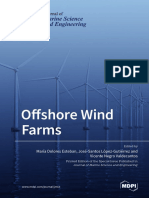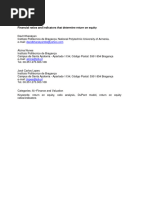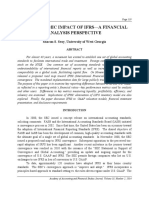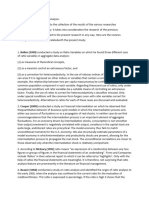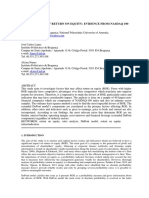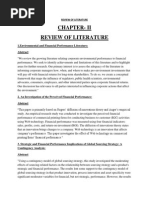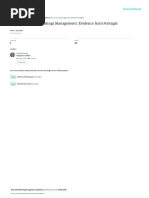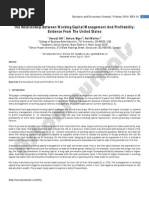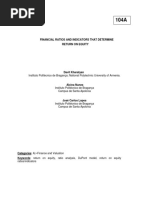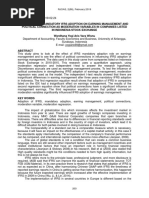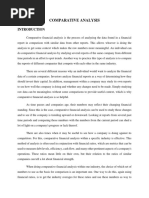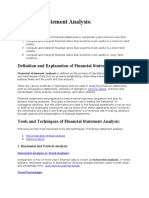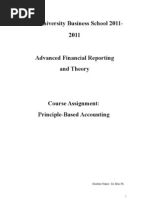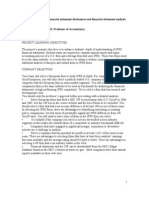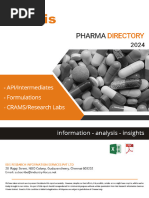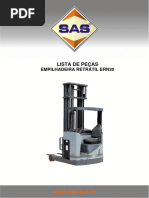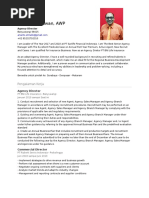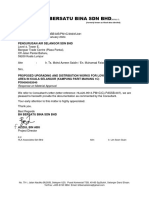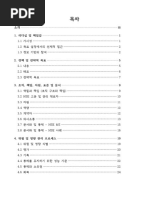Kelompok 2 PDF
Kelompok 2 PDF
Uploaded by
Irvan Sii CoffeeCopyright:
Available Formats
Kelompok 2 PDF
Kelompok 2 PDF
Uploaded by
Irvan Sii CoffeeOriginal Description:
Original Title
Copyright
Available Formats
Share this document
Did you find this document useful?
Is this content inappropriate?
Copyright:
Available Formats
Kelompok 2 PDF
Kelompok 2 PDF
Uploaded by
Irvan Sii CoffeeCopyright:
Available Formats
Auditor Style and Financial Statement Comparability*
by
Jere R. Francis
Trulaske College of Business
University of Missouri
Columbia, MO 65211 USA
Francis@missouri.edu
Matt Pinnuck
Faculty of Business and Economics
University of Melbourne
Melbourne 3110 Australia
mpinnuck@unimelb.edu.au
Olena Watanabe
College of Business
Iowa State University
Ames, IA 50011 USA
watanabe@iastate.edu
Draft Date: June 21, 2013
*We appreciate the comments of workshop participants at University of Arizona, Bocconi
University, Bond University, HEC Montreal, Laval University, Michigan State University,
University of Missouri, Washington University in St. Louis, and the comments of participants at
the annual meetings of the American Accounting Association and the International Symposium
on Audit Research.
Contact Author:
Jere Francis
+01 573 882 5156
Francis@missouri.edu
Auditor Style and Financial Statement Comparability
ABSTRACT: The term audit style is used to characterize the unique set of internal working
rules of each Big 4 audit firm for the implementation of auditing standards, and the enforcement
of GAAP within their clienteles. Audit style implies that two companies audited by the same Big
4 auditor, subject to the same audit style, are more likely to have comparable earnings than two
firms audited by two different Big 4 firms with different styles. By comparable we mean that two
firms in the same industry and year will have a more similar accruals and earnings structure. For
a sample of U.S. companies for the period 1987 to 2011, we find evidence consistent with audit
style increasing the comparability of reported earnings within a Big 4 auditors clientele.
Keywords: Earnings; Comparability; Big 4 Accounting Firms.
Data availability: All data are publicly available from the sources identified in the text.
1
Auditor Style and Financial Statement Comparability
I. INTRODUCTION
Comparability is defined by the Financial Accounting Standards Board (FASB) as the
quality of information that enables users to identify similarities and differences in the financial
performance of two firms. The joint conceptual framework project of FASB and the International
Accounting Standards Board (IASB) emphasizes that comparability is a basic property of
financial information which enhances its usefulness (FASB 2010). Indeed the FASB states that
comparability in financial reporting is the primary reason for developing accounting standards
(FASB 1980, par. 112). The centrality of comparability is also embedded in accounting
textbooks, particularly financial statement analysis texts (Revsine et al. 2011; Phillips et al.
2013).
The primacy of comparability as a qualitative characteristic of accounting makes it
important to understand the factors that give rise to this characteristic. The emerging research
into the determinants of comparability has focused on the role of accounting standards such as
the adoption of IFRS (Barth et al. 2012; Lang et al. 2010). However, accounting standards on
their own do not fully determine financial reporting outcomes; economic agents and institutional
incentives also play an important role (Ball et al. 2003; Leuz et al. 2003). This motivates our
investigation of the role that auditors play in the implementation of comparability in the United
States. An advantage of studying financial statement comparability in a single-country setting is
that we avoid the potential confounding effect of institutional differences in cross-country
studies.
The concept and use of the word comparability differs in the literature. For the purpose of
our study we define accounting comparability as the closeness of two firms reported earnings
due to the consistency with which rules are applied across firms. In our empirical context, this
2
means that firm-pairs in the same industry and fiscal year, and therefore subject to the same
general economic shocks, are expected to have a similar accruals and earnings structure, all
things being equal. However, there are frictions in the interpretation, implementation, and
enforcement of accounting standards which can reduce inter-company comparability. Our study
focuses on the role of the auditor, and following Kothari et al. (2010) we argue that each Big 4
audit firm has its own unique set of internal working rules that guide and standardize the
auditors application of auditing and accounting standards. These working rules give rise to what
we term audit style, with the consequence that audit firms have systematic differences in their
audit approaches, and in their interpretation and enforcement of accounting standards. As a
result, we expect reported accruals and earnings to be more consistent and comparable within an
audit firms clientele than between audit firm clienteles. This leads to our main hypothesis: two
companies audited by the same Big 4 auditor, and therefore subject to the same audit style, are
more likely to have comparable earnings than two companies audited by two different Big 4
auditors and subject to different audit styles.
1
We measure accounting comparability in three ways. The first approach is to examine
differences in year-specific total and abnormal accruals between pairs of firms in the same
1
Some recent examples provide anecdotal evidence of auditor style effects. In a field study, Dichev et al (2013 p.
32) cite CFOs on the effect of auditors on earnings:
The big [accounting] firms are not passing authority downstream to the regional headquarters or onto the actual
auditors like they used to Interpretation of these rules in the accounting firms comes from high above now rather
than from the field.
earlier you could work with your local accounting firm, your local partner and accomplish things. Now pretty
much everything goes up to their think tank at national.
The implication is that the work of accounting firms is standardized across their clienteles, consistent with a style
effect. Another example is from Blacconiere et al. (2011) who study firms making voluntary disclosures which
disavow the reliability of mandated fair value information. Their descriptive statistics show that Ernst and Young
(E&Y) clients are four times more likely to disavow the reliability of mandated fair value disclosures than are the
clients of other national audit firms. E&Y included a disavowal as an illustrative disclosure in its SFAS No. 123
implementation guidance (E&Y 1995), and their clients used this wording almost verbatim in their disavowal
disclosures.
3
industry using the same Big 4 auditor versus firm-pairs with two different Big 4 auditors. The
second approach measures the degree to which the earnings of a pair of firms in the same
industry, and audited by the same Big 4 auditor, covary across time (Barth et al. 2012; De Franco
et al. 2011; Lang et al. 2010). The third approach follows the CEO/CFO style literature and uses
an auditor fixed effects model to examine the commonality of accruals for auditor clienteles
(Bamber et al. 2010; Ge et al. 2011).
The primary tests are based on pairs of firm-year observations from Compustat in the
same industry-year for the period 1987 to 2011. Consistent with our main hypothesis, we find
that two firms in the same industry-year and audited by the same Big 4 auditor have more
comparable earnings than two firms audited by two different Big 4 auditors. These results are
consistent across the three empirical tests: pairs of firms in the same industry-year with the same
Big 4 auditor have more similar total and abnormal accruals; firm-pairs with the same Big 4
auditor have a higher covariation in earnings over time; and auditor fixed effects are a
statistically significant determinant of accruals. These results are robust to a set of controls for
other factors that might create frictions or otherwise affect the comparability of accruals and
earnings for firm-pairs. The findings are consistent with each Big 4 audit firm having a unique
style that increases the comparability of earnings within its clientele.
We also examine whether a pair of companies audited by the same Big 4 auditor will
have more comparable earnings than a pair of companies audited by non-Big 4 auditors. The test
is based on the argument that Big 4 auditors, due to their size and economies of scale, will have a
greater capacity than non-Big 4 auditors to incur the fixed costs in developing standardized in-
house rules for implementing auditing standards and the enforcement of GAAP. Consistent with
4
this prediction we report evidence that Big 4 auditors have a greater effect on accounting
comparability than non-Big 4 auditors.
The study makes several contributions to the literature. This is the first study to
hypothesize and test the role of economic institutions within a country in the production of
comparability. The existing debate and empirical evidence in regard to the production of
comparability has focused almost exclusively on the role of standards themselves, especially
FASB versus IFRS. Our study provides evidence that an economic institution the auditor is
also an important factor in the production of financial statement comparability. Consistent with
the joint FASB/IASB conceptual framework, our results suggest that accounting standards alone
may not necessarily lead to comparability, but that the effects of standards are also dependent
upon audit firms involved in the enforcement of GAAP. As such, we document a new channel
through which auditor characteristics affect audited financial statements.
Second, we contribute to the debate on principles versus rules in the development of
accounting standards by regulators. Kothari et al. (2010) argue that regulators should not be
concerned with the potential for non-comparability if accounting standards are principle-based,
because accountants and auditors who are involved in the day-to-day application of principles
will develop working rules to standardize accounting practice. Our results suggest that this
standardization process occurs within the clientele of one auditor; however, there are significant
style differences between audit firms that reduces inter-auditor comparability.
Third, we contribute to the broader literature that examines the auditors role in the
production of financial reports. This literature has mainly examined the role of auditing in
curbing earnings management, which is related to the qualitative characteristic of
representational faithfulness (FASB 2010). We show that the unique style of each Big 4
5
auditor affects the qualitative characteristic of comparability, and this is another source of
variation within the Big 4 group of auditors. Our study and results are therefore related to
Bamber et al. (2010) who report that individual corporate managers have their own individual
style in choice of voluntary corporate financial disclosure, and Ge et al. (2011) who find that
CFO style affects the choice of accounting policies. We extend the concept of unique styles in
the production of financial reports from individuals to accounting firms. Our finding is analogous
to the finance literature that examines mutual funds and which documents that funds have their
own unique styles (Barberis and Shleifer 2003).
The next section develops the studys two hypotheses. The research design is presented in
section three, and sample selection and data are summarized in section four. Empirical results are
reported in sections five through eight. Section nine discusses the economic magnitudes of the
results, and section 10 concludes the study.
II. HYPOTHESIS DEVELOPMENT
Two lines of research are relevant to this study: research that examines financial
statement comparability, and research linking auditor characteristics with earnings attributes.
While the importance of comparability has long been recognized by standard setters, and
discussed in the academic literature at a conceptual and normative level, there is much less
empirical research on comparability. Recent empirical papers have emerged in response to the
development of new methodologies to measure comparability, and to the widespread adoption of
IFRS. These papers examine how the adoption of IFRS affects financial statement comparability,
and how improved comparability affects decisions by investors. For example, Barth et al. (2012)
examine the comparability of financial statement of non-U.S. firms that adopt IFRS with that of
U.S firms, and find that IFRS adoption by non-U.S. firms enhances their financial statement
6
comparability with U.S. firms. Lang et al. (2010) examine changes in cross-country financial
statement comparability around mandatory IFRS adoption and document that IFRS adoption
increases comparability, measured as cross-country earnings co-movement. Other recent papers
have examined whether comparability affects the decisions of participants in the capital market.
De Franco et al. (2011) find that earnings comparability within an industry is positively related to
analysts following and accuracy, and negatively related to analysts optimism and dispersion in
earnings forecasts. Bradshaw et al. (2011) also study analysts and find that the commonality of
accounting policy choices, their measure of comparability, affects analyst coverage and behavior.
Lastly, DeFond et al. (2011) show that mutual funds increase their foreign investment in
countries with mandatory IFRS adoption, which they argue is due to improved cross-country
earnings comparability.
Turning to the auditing literature, a large body of research has examined the association
of auditor characteristics with clients audited earnings. The seminal studies linking auditors and
earnings attributes are Becker et al. (1998) and Francis et al. (1999), who document that Big 4
clients have smaller abnormal accruals than non-Big 4 clients. This stream of research has also
examined other earnings attributes such as benchmark beating (Burgstahler and Dichev 1997;
Frankel et al. 2002), accruals quality (Dechow and Dichev 2002; Doyle et al. 2007), and timely
loss recognition (Basu 1997; Krishnan 2005). Francis (2004; 2011) reviews the empirical
auditing literature and describes auditor characteristics associated with earnings quality,
including the Big 4/non-Big 4 dichotomy, the auditors industry expertise (Reichelt and Wang
2010), and engagement-specific factors such as client size (Reynolds and Francis 2000), auditor
tenure (Johnson et al. 2002), auditor-provided nonaudit services (Frankel et al. 2002), and the
presence of audit firm alumni in executive positions of clients (Menon and Williams 2004).
7
We bring the comparability and audit research streams together to investigate the role of
the auditor in comparability. While prior comparability research has examined the capital market
effects from the global harmonization of standards, we know of no attempts to empirically
document the role of economic agents such as auditors on financial statement comparability.
Barth et al. (2012) recognize that accounting reports are the result of a complex interaction of the
features of the financial reporting system which include accounting standards, their
interpretation, enforcement, and litigation, all of which can affect comparability. Apart from the
actual accounting standards themselves, which are exogenously given, the auditor is actively
involved in all of these features of the financial reporting system. The audit research literature, in
turn, has focused on the role of the auditor in facilitating the reporting of high-quality earnings,
with the primary emphasis on accruals quality and earnings management behavior. We extend
this line of research to investigate the role the auditor plays in facilitating comparability.
Our argument is that each Big 4 audit firm has its own unique audit testing approach for
implementing GAAS along with in-house working rules for interpreting and applying GAAP.
The policies of each Big 4 firm will give rise to what we term an audit style, and we expect
auditor style to have a systematic effect on clientele earnings. It is well-known that each Big 4
accounting firm has its own unique audit methodology and testing procedures. For example,
Kinney (1986) classified the then Big 8 accounting firms based on their use of unstructured,
intermediate, and structured audit technologies. While audit methods/procedures must comply
with generally accepted audit standards (GAAS), the audit standards are themselves rather
general in nature and much more principles-based than is U.S. GAAP. This means that each
accounting firm must devise its own in-house working rules for the efficient and consistent
implementation of GAAS across its client base (Cushing and Loebbecke 1986). Auditors also
8
attempt to differentiate themselves from one another based on their methodologies. For example,
in the 1980s there was a dichotomy between auditors that used a quantitative approach versus
those that used a qualitative methodology (Kaplan et al. 1990). In the 1990s, KPMG promoted its
business risk audit as an innovation (Bell et al. 1997). These divergent practices are also
illustrative of the kinds of technical innovation that Kothari et al. (2010) argue is more likely to
occur when standards, in this case auditing standards, are principles-based rather than rule-based.
The unique character of audit methodologies implies that each firms audit approach will
systematically detect or not detect the same client errors, including GAAP implementation
errors. The implication is that financial statements will be more similar for firm-pairs with the
same auditor, ceteris paribus, than for firm-pairs with two different auditors each having
different styles.
2
Turning to style effects that arise from GAAP interpretation, it may not be as well-
known, but each of the Big 4 accounting firms also has in-house rules for interpreting and
implementing GAAP, just as it has for implementing auditing standards (GAAS). Kothari et al.
(2010) develop the general argument that a principles-based approach to GAAP does not
eliminate the role of rules. Instead a principles-based approach to GAAP will result in
economic agents such as auditors developing in-house working rules for the consistent
interpretation and implementation of standards. Kothari et al. (2010, 277) state that:
It is not likely to be cost effective for accountants and auditors to work with principles
on a day-to-day basis. Authority on interpreting and implementing GAAP in an economy has to
be delegated to thousands of rank-and-file accountants and auditors (for reasons of efficiency);
this is possible only if working rules are formulated out of principles.
2
Vera-Munoz et al. (2006), Banker et al. (2002), Dowling (2009) report that accounting firms also use information
technology systems to standardize the implementation of audit methodologies and that firms also standardize the
documentation of audits using electronic templates for working papers that embed the audit firms methodology.
Zerni (2012) identifies the following software products: KPMGs KWorldTM, PricewaterhouseCoopers
TeamAssetTM and KnowledgeCurveTM, and Ernst & Youngs KnowledgeWebTM.
9
While there is more guidance in U.S. GAAP than in the relatively more principles-based
international financial reporting standards (IFRS), the Big 4 accounting firms will still find it
advantageous to develop their own in-house working rules because U.S. GAAP still requires
considerable judgment in interpreting and implementing accounting standards. As a result, each
Big 4 firm has its own in-house GAAP guide that is used internally by its auditors in the field.
To illustrate this point, we have identified the following current products developed by
each Big 4 accounting firm for internal use by audit staff:
Deloitte:
Deloitte Technical Library (http://www.deloitte.com/us/techlibrary)
Deloitte Roadmap (http://www.deloitte.com/view/en_US/us/Services/audit-enterprise-risk-
services/Financial-Statement-Internal-Control-Audit/Accounting-Standards-
Communications/980bef5fe91fb110VgnVCM100000ba42f00aRCRD.htm).
Ernst & Young:
Global Accounting and Auditing Information Tool (GAAIT)
(http://www.ey.com/GL/en/Services/Assurance/Assurance-Key-A-A-Guidance-On-Ernst---
Young-Online---Global-Accounting---Auditing-Information-Tool).
KPMG:
Accounting Research Online
(http://www.kpmg.com/Global/en/WhatWeDo/Audit/Pages/Accounting-research-online.aspx).
PricewaterhouseCoopers:
Accounting Guides
(http://www.cfodirect.pwc.com/CFODirectWeb/Controller.jpf?NavCode=MSRA-777JJY).
Each Big 4 firm explicitly states that their product represents a guide for the
interpretation and application of GAAP. For example, Ernst & Young characterize their product
as a global online resource for accounting and auditing standards, which represents Ernst &
Youngs interpretative guidance for US GAAP, international GAAP, and other GAAP systems.
Deloitte says its Technical Library provides interpretative guidance for GAAP, and KPMG says
10
its guide contains regulatory pronouncements, and KPMGs guidance on new pronouncements
including illustrative examples to facilitate the practical application of standards.
While accounting firms originally developed these materials for internal use by their
audit staff, they also provide some of the same information to their clients. In other words,
clients are likely to be using their auditors GAAP guidance products in preparing financial
statements. Deloittes Technical Library has a subscription price of $2,000, and Ernst & Youngs
Global Accounting and Auditing Information Tool (GAAIT) has a base price of $750. KPMGs
Accounting Research Online is also available by subscription, and PricewaterhouseCoopers
provides their accounting guides by subscription through its CFOdirect Network. In addition, our
discussions with Big 4 practitioners reveal that when a complex accounting issue arises in the
preparation of financial reports, the CFO will often seek guidance from the Technical
Department of the firms Big 4 auditor.
3
The working rules of Big 4 auditors are an important mechanism through which GAAP is
operationalized and implemented by both auditors and their clients, even within the United States
with its arguably more explicit rule-based standards. The upshot is that two companies with the
same Big 4 accounting firm as their auditor are more likely to interpret and implement GAAP in
the same way, including the role of the auditor in enforcing GAAP and detecting GAAP
misapplications for its clientele through the firms standardized audit methodology.
Thus if there are auditor style effects on their clienteles financial reports, we should
observe greater consistency in the financial statements of two companies in the same industry-
3
The existence of in-house rules is supported by Acito et al. (2009) who investigate accounting for operating leases,
and subsequent restatements for the misreporting of these leases. Table 4 of their paper uses an auditor fixed effects
model and finds systematic differences between auditor clienteles in the frequency of restatements that corrected
lease accounting errors. This finding suggests that auditors had different GAAP interpretations with respect to lease
accounting, which resulted in different rates of subsequent client restatements.
11
year audited by the same Big 4 audit firm relative to firm-pairs with two different Big 4 audit
firms where the effect of style is randomized away. Our first hypothesis, in alternative form, is:
H1: A pair of companies audited by the same Big 4 audit firm will have more
comparable earnings than a pair of companies audited by two different Big 4 audit firms.
DeFond et al. (2011) point out that while comparability is the desired outcome of
adopting a set of uniform accounting standards, uniformity alone does not necessarily result in
comparability. In particular, the standards and in-house rules must also be faithfully
implemented. This leads us to predict that the financial statements of a pair of firms with the
same Big 4 auditor will have a greater comparability than financial statements of a pair of firms
with the same non-Big 4 auditor. Because Big 4 auditors are larger, they have a greater capacity
to incur the fixed cost investments in audit programs and in-house rules for interpreting and
implementing GAAP through technical guidelines. Second, because Big 4 auditors have a
larger and more dispersed staff, they have greater incentive/need for staff controls than smaller
firms. For these reasons we predict that Big 4 audit firms will have a greater style effect than
non-Big 4 audit firms. Finally, higher quality auditors are more likely to correctly apply
accounting standards, and prior research has found that non-Big 4 auditors are associated with
lower-quality audited earnings (Teoh and Wong 1993; Becker et al. 1998; Francis et al. 1999).
4
Because managers have flexibility in the application of accounting standards, comparability will
be greater among companies with Big 4 auditors because the accounting standards are applied on
a more consistent and correct basis. Thus we predict increased financial statement comparability
for firms with Big 4 auditors, and the second hypothesis in alternative form is:
H2: A pair of companies audited by the same Big 4 audit firm will have more
comparable earnings than a pair of companies audited by the same non-Big 4 audit firm.
4
There is also evidence that mid-tier audit firms with national practices provide higher quality audits than smaller
non-Big 4 firms (Francis et al. 1999), and in the post-SOX period some studies report that audit quality differences
have narrowed between the Big 4 firms and mid-tier firms (Boone et al. 2010; Cassell et al. 2013).
12
III. RESEARCH DESIGN
Prior earnings comparability research has typically analyzed either (1) cross-sectional
similarities in the levels of contemporaneous measures (Joos and Lang 1994); or (2) the
correlation of earnings (covariation) across time (Barth et al. 2012; De Franco et al. 2011).
5
To
test H1 we build on this research and use method (1) to test cross-sectional similarities of
accruals for firm-pairs, and method (2) to test the correlation of earnings for firm-pairs across
time. For robustness, and to provide a link to the CEO/CFO style literature, we use an auditor
fixed effects model to test for systematic accounting similarities within audit firm clienteles.
Empirical tests of H1
Differences in accruals
Our first approach to testing accounting comparability is to examine the similarity of
closeness of accruals for pairs of firms in the same industry, at a common point in time,
conditional on audit firm. This approach is based on and extends prior comparability research
that has examined similarities in cross-sectional levels of contemporaneous measures such as
return on equity and price multiples to investigate cross-country convergence in firm-specific
earnings multiples (Joos and Lang 1994; Land and Lang 2002). Our approach is conceptually
similar except that we are examining auditors as an institutional factor giving rise to
comparability and the convergence of earnings within a single country.
Our analysis examines accruals because it is the primary component of earnings that is
subject to discretion and is the component through which economic agents such as auditors can
most directly affect comparability. The premise is that two firms in the same industry and year,
and audited by the same Big 4 auditor, are more likely to have the same type of accrual
5
An alternative approach uses the similarity of accounting policy choices (Bradshaw and Miller 2007; Bradshaw et
al. 2011). We do not use this approach because of limited data availability on accounting method choices.
13
adjustments due to audit methodology, and to make the same set of accounting choices and
judgments in implementing GAAP. Therefore, the accruals structure of these firms will be more
similar than that of two firms with different auditors where the effect of audit style will be
randomized away. We measure the similarity of accruals as follows:
Diff_Total_Accruals
ijt
= abs (Total_Accruals
it
Total_Accruals
jt
), (1)
where Diff_Total_Accruals
ijt
is the absolute value of the difference between signed total accruals
for firm-pairs in the same SIC two-digit industry classification in year t. We calculate this
comparability metric for each firm i and firm j pairwise combination, for J firms in the same
industry and fiscal year. We control for economic fundamentals and exogenous shocks because
our analysis examines firm-pairs within the same industry and year where the accruals structure
should be similar, ceteris paribus.
Total accruals are calculated as the difference between income before extraordinary items
and cash flows from operations adjusted for cash flows from extraordinary items (IB (OANCF
XIDOC)), scaled by beginning of year total assets. We use the same approach to calculate
differences in abnormal accruals, which we label Diff_Abn_Accruals
ijt
. Abnormal accruals are
calculated using the Jones (1991) model of discretionary accruals, with control for
contemporaneous performance (Kothari et al. 2005). Hypothesis H1 predicts that financial
statements for firm-pairs in the same industry-year with the same Big 4 auditor, will report a
more similar accrual structure, and therefore will have smaller differences in both total accruals
and abnormal accruals.
Earnings covariation
A second way of measuring accounting comparability is the degree to which earnings for
firm-pairs in the same industry covary over time (Barth et al. 2012; De Franco et al. 2011). This
14
approach should be less subject to omitted variables that could affect the accrual-difference
metric which may capture a number of properties other than comparability. The specific
approach we employ follows De Franco et al. (2011), hereafter DKV, who measure
comparability as the degree to which earnings for two firms in the same industry covary over
time.
6
Following DKV, we measure the level of covariance as the adjusted R
2
from the
following regression:
Earnings
iq
=
0ij
+
1ij
Earnings
jq
+
ijq
(2)
where Earnings is income before extraordinary items for firm i and firm j for quarter q scaled by
average total assets of each firm. The model in equation (2) is estimated over 16 consecutive
quarters q for all unique pairs of firms in the same 2-digit SIC industry. We measure the
accounting comparability of firm i and firm j in equation (2) as the adjusted R
2
from the
regression, hereafter referred to as earnings comparability covariation, or ECOMP_COV. Higher
values of ECOMP_COV indicate greater earnings comparability between firm-pairs. Hypothesis
H1 predicts that earning covariation is greater for firm-pairs with the same Big 4 auditor.
7
6
DKV suggest two approaches for measuring comparability, an approach based on the similarity of the mapping of
earnings to stock returns across firms, and an approach based on the covariation in earnings across firms. We use the
latter approach in our study, the earnings covariation metric, because it is a more direct test of the arguments that
underpin our hypothesis. As Lang et al. (2010) point out, the DKV comparability metric of mapping earnings to
stock returns measures whether earnings are similarly capturing the underlying economic, while an earnings
covariation metric captures anything that creates earnings similarity, regardless of whether the underlying
economics are indeed similar. Hypothesis H1 in our study is underpinned by the concept of auditors having in-house
rules which causes them to impose the same accounting choices on their clientele, regardless of the underlying
economics, which leads to covariation in earnings. For this reason we use the earnings covariation metric and do not
measure comparability based on the similarity of the mapping of earnings to stock returns because it is a
fundamentally different construct.
7
The earnings covariation metric uses quarterly earnings data and the observable effects of the auditor on
comparability may be weaker in quarterly data compared to annual earnings because only the annual earnings are
subject to a full scope audit (Brown and Pinello 2007). In contrast, interim earnings numbers for the first three
quarters are simply reviewed by the auditor. Under the integrated reporting model, fourth quarter earnings must be
equal to annual earnings less the sum of the first three quarters, so the fourth quarter earnings can be also noisy due
to the implicit adjustments for prior-quarter estimation errors. While we can expect the auditor to influence the
implementation of GAAP over the entire year, we do not expect the influence of audit style on earnings
comparability to be as strong in quarterly data as it would be in fully audited annual earnings. This results in a
design trade-off. While annual data would more appropriate in our research context, it is not practical to use annual
data given the long time series required to calculate earnings covariation. Further, the testing framework requires
15
A potential limitation of the earnings covariation metric is that it does not explicitly
control for economic shocks which are crucial to isolating accounting comparability. Following
DKV, we address this issue in three ways. First, we perform all our analysis on firm-pairs within
industry by year, thereby controlling for common economic fundamentals and shocks. Second,
we control for contemporaneous cash flow covariation for firm-pairs, which is measured
analogously to ECOMP_COV. Specifically, CFO_COMP_COV is created in an identical manner
to ECOMP_COV except that in equation (2) we replace Earnings with CFO, which is the ratio of
quarterly cash flow from operations to the beginning of period market value. Finally, we control
for contemporaneous monthly stock return covariation (RET_COV) for firm-pairs, which is
measured analogously to ECOMP_COV. Stock returns will reflect all economic shocks and
provides a further control for the effect of underlying economic fundamentals on accruals.
Regression models
To examine the relation between accounting comparability and auditor style we estimate
the following OLS regression models:
Diff_Total_Accruals
ijt
(Diff_Abn_Accruals
ijt
) =
0ij
+
1
Same_Big4
jt
+
2
Controls +
ijt
. (3)
ECOMP_COV
ijt
=
0ij
+
1
Same_Big4
jt
+
2
CFO_COMP_COV+
3
RET_COV +
4
Controls. (4)
All tests are based on robust t-statistics which control for heteroscedasticity and with standard
errors clustered at the firm level to control for potential non-independence (Petersen 2009).
Results are robust to clustering by both firm and year, and to alternative clustering by unique
firm-pairs.
8
that a firm have the same auditor over the time series, which is also less likely when using a longer time series of
annual data.
8
The dependent variable in regression model (3) is truncated at zero, which under certain conditions can lead to
biased OLS estimators. However this is unlikely to be an issue in our setting as we have very few zero-value
observations. Nevertheless we also estimate model (3) using a Tobit regression and the results remain unchanged.
16
The regression models in equations (3) and (4) are estimated using a sample of firm-pairs
that have the same Big 4 auditor versus firm-pairs with two different Big 4 auditors. Because our
data extends to the era of the Big 8 accounting firms, each accounting firm is treated as unique
for the years in which it exists in the sample data. For example, a firm audited by Price
Waterhouse in 1997, and by PricewaterhouseCoopers in 1998, is treated as having a different
auditor in each year. For convenience, we use the term Big 4 to refer to all of these auditors.
To test H1 we use the indicator variable, Same_Big4, which is coded 1 if the auditor for a
pair of firms is the same Big 4 firm, and 0 if auditors in a pair of firms are two different Big 4
auditors. In equation (3) we predict a negative coefficient on
Same_Big4 because a lower value
of Diff_Total_Accruals indicates a smaller difference in accruals and hence greater cross-
sectional comparability of earnings. In contrast, in equation (4), we predict a positive coefficient
on Same_Big4
because a larger value of ECOMP_COV
indicates greater earnings covariation
over time, and hence greater time series comparability of earnings.
Lang et al. (2010) point out there is no theoretical or empirical guidance concerning
appropriate control variables to include in a regression that explains earnings comparability, and
include control variables for size and book-to-market on the basis that these variables are widely
used to capture many unobservable firm-specific characteristics. We include these variables but
also control for a wider range of other variables identified in the literature that could result in the
earnings between two firms being similar due to either economic fundamentals (e.g., volatility of
operations) or the propensity to manage earnings (e.g., market-to-book ratio or leverage). The
full set of control variables are: size, leverage, market-to-book, cash flow from operations,
17
losses, standard deviation of sales, standard deviation of cash flows, and sales growth.
9
Due to
the absence of theory, we make no predictions as to what the signs of the coefficients on the
control variables should be. In addition, in model (3) we also include the level of accruals as an
independent variable to control for the finding from prior audit research that accrual levels differ
across auditor clienteles (Becker et al. 1998; Francis et al. 1999). Therefore, regression model (3)
examines whether auditors have an effect on the comparability of earnings that is incremental to
their effect on accruals quality. We also include industry fixed effects at the two-digit SIC
industry classification as a further control for innate firm characteristics and potential omitted
variables. Test variables and control variables are defined in the Appendix.
Since the dependent variable is calculated each year t for a pair of firms i and j, the
control variables must also control for yearly characteristics of the firm-pair i and j. Following
prior research that has used pairs of firms, we control for both the levels and differences in firm-
pair characteristics (Francis et al. 2009; De Franco et al. 2011). For the regressions which have
Diff_Total_Accruals
ijt
and Diff_Abn_Accruals
ijt
as the dependent variable we control for levels
by entering the minimum value in each year t for the paired control variables for firm i and j.
10
The differences are measured by the absolute values of yearly differences in the control variable
values for firm i and firm j. For the regressions which have ECOMP_COV as the dependent
variable we follow the same approach. However, for these regressions, the dependent variable is
constructed from the correlation of earnings across 16 consecutive quarters for firm-pairs. We
therefore estimate the average of each control variable for each firm i and each firm j across the
9
In regression (3) using Diff_Total_Accruals
as the dependent variable, we include cash flow from operations to
control for cash flow fundamentals. For the regression in equation (4) using ECOMP_COV as the dependent
variable, we included the variable CFO_COMP_COV to control for cash flow fundamentals.
10
As an alternative control, we use the average value in each year t for the paired control variables for firm i and
firm j. This shows similar results to entering the minimum of each firm pair and all conclusions remain the same.
18
corresponding 16 quarters. We use averages of each firm to construct the average minimum
value, and differences in these averaged values are used to construct the difference metric.
IV. SAMPLE SELECTION AND DATA
Sample construction
We begin with all non-missing observations for Compustat firms incorporated in the U.S.
with data from 1987 through 2011. We use this period because we require Cash Flows from
Operations as a control variable and also to measure total accruals (earnings minus cash flows),
and this data became available in 1987. Following De Franco et al. (2011) we retain firms with
fiscal year ends in March, June, September and December. We retain only observations with at
least 20 firms in a given two-digit industry, and delete firms with names containing
HOLDING, HOLDINGS, ADR, partnership, LP, LLP. We also delete all firms
which report negative total assets or total assets less than $10 million, and firm-year observations
in a year in which the firm switches its auditor. Further, the sample is constrained by the
availability of Cash Flows from Operations as noted above. Finally, we winsorize all
continuous variables at 1 percent and 99 percent.
We begin with the accruals-difference sample, in which all firms in an industry-year are
exhaustively paired. For example, if there are three firms A, B, and C, then the firm-pairs would
be A-B, B-C, and A-C. The earnings co-movement tests are based on a subsample of the
accruals-differences sample. Specifically, we keep only those firms from the accruals-difference
sample that have data for all variables for 16 consecutive quarters and that did not change
auditors during the 16 quarter period. A firm-pair first enters the sample when 16 consecutive
quarters of data first becomes available. To alleviate any concern in regard to the robustness of
19
the t statistics, we use firm-pair observations with non-overlapping four-year periods to mitigate
concerns over non-independence of error terms.
11
During the sample period there were several audit firm mergers. For all our tests we only
compare pairs of firms audited by the same auditor.
12
This has no effect on the accruals tests
which are based on yearly cross-sectional data. However, it does result in a reduced sample for
the ECOMP_COV analysis because this metric requires firm i to have the same exact audit firm
across a four-year (16-quarter) period.
Descriptive statistics
Table 1, Panel A reports descriptive statistics for all variables in the study. The test
variable Same_Big4 is coded one for 22.2 percent of the sample. For the accrual-difference
metrics, the mean difference in total accruals (abnormal accruals) between firm-pairs is 11.3
(10.6) percent of total assets. The mean value of ECOMP_COV is an adjusted r-square of 11.4
percent, similar to the 11.2 percent reported by De Franco et al. (2011). Panel B reports the
correlation between ECOMP_COV and the accruals-difference metrics and shows a statistically
negative association as would be predicted because larger accrual differences imply lower
earnings comparability, although the magnitude of the correlations is only r = 0.05. The low
correlation reflects: (1) the fact that accrual differences are measured after removing variation in
earnings due to cash flows, while ECOMP_COV includes variation due to cash flows; (2) the
accrual metric is a yearly cross-sectional measure while ECOMP_COV measures comparability
across time; and (3) it is well-documented there is noise in any earnings-attribute metric.
11
For example, if we estimate ECOMP_COV
ij
for the firm-pair i and j using 16 consecutive quarterly observations
from 1988 to 1991, then the next estimated observation of ECOMP_COV
ij
for the firm-pair i and j that we would
include in the sample is based on the 16 consecutive quarterly observations from 1992 to 1995.
12
Touche Ross merged with Deloitte Haskins and Sells on December 4, 1989 to form Deloitte Touche (later
renamed Deloitte); Coopers & Lybrand merged with Price Waterhouse on July 1, 1998 to form
PricewaterhouseCoopers, and Arthur Young merged with Ernst & Whinney on October 1, 1989 to form Ernst &
Young.
20
[Insert Table 1 Here]
V. ACCRUAL DIFFERENCES
Primary results
Table 2 reports the estimation of firm-pair differences in total and abnormal accruals. In
the test of H1, the coefficient on Same_Big4 is negative and statistically significant at p < .01
(two-tail) for both differences in total accruals and differences in abnormal accruals. This is
consistent with greater similarity in the accruals structure for firm-pairs audited by the same Big
4 auditor, and supports H1 regarding the effect of audit firm style on accounting comparability.
The signs of the coefficients on the control variables are generally as expected. Accruals_Min,
Size_Min, CFO_Min all have negative coefficients. As the minimum level of accruals, firm size,
and cash flows increases in magnitude, firm-pairs are likely be more similar and therefore are
more likely to have a similar accruals structure and smaller differences in accruals.
[Insert Table 2 Here]
Auditor changes
The next analysis is limited to subsamples where there is an auditor change for the firm-
pair. We begin with the notion that if a pair of firms has different auditors and one of the firms
changes auditor to have the same auditor as the other firm, then after the switch we should
observe a more similar accruals structure resulting in smaller differences because the two firms
are now subject to the style effects of the same auditor. To test this expectation, we re-estimate
the regression model in equation (3) for a subsample of firm-pairs that have switched from
having two different Big 4 auditors (pre-switch) to having the same Big 4 auditor post-switch:
Diff_Total_Accruals
ijt
(Diff_Abn_Accruals
ijt
) =
0ij
+
1
S
_
Switch
jt
+
2
Controls +
ijt
, (5)
21
where S_Switch is an indicator variable that takes the value of one in the test years following the
switch (same auditor), and the value of zero in the benchmark years prior to switch (different
auditors). Therefore the indicator variable S_Switch compares the differences in accruals for the
same pair of firms, before and after the switch. We predict a negative coefficient if switching to
the same auditor decreases the accrual differences for a pair of firms. The dependent variable and
control variables are the same as previously described. We estimate this regression across three
alternative periods of increasing length before and after the switch.
We begin by comparing accruals differences two years before (t2 and t1), and three
years after the switch t0, t+1, and t+2, where the first year of the new auditor is denoted t0.
13
We
then expand this to three years prior to the switch (t3 through t1) and four years after the
switch (t0 through t+3), and finally on to four years before and five years after the switch, t4 to
t+4. As reported in Panel A, Table 3, the results across all sub-periods examined show that the
predicted coefficient on S_Switch is negative as expected, and statistically significant at p < 0.01,
except for Abn_Accr_diff in the period t4 to t+4, which is significant at p < .10. These results
for years around auditor changes, provide compelling evidence that auditor style has an effect on
clientele accruals, and that a change to the same auditor leads to more similar accruals.
[Insert Table 3 Here]
For completeness, we also examine the situation where firm-pairs have the same auditor,
and one of them changes auditors so that the firm pair now has two different auditors. We
estimate the same regression as in equation (5) except we include an indicator variable D_Switch
that takes the value of one in the test years following the switch to different auditors, and the
value of zero in the benchmark years prior to switch when the pair of companies had the same
13
We allow a three-year transitional period for the new auditor to imprint their style on the grounds that it will take
more than one year to do so. However, in untabulated tests we find the same result if we compare just the last year
before the switch (two different audit firms) and the first year after the switch (the same audit firm).
22
auditor. The results are reported in Table 3, Panel B. Across all test periods, the coefficient on
D_Switch is not statistically significant from zero. Therefore, there is no evidence that a change
to different auditors reduced comparability in the post-switch period. We have no explanation for
why the evidence from the two sets of switching tests in Table 3 is not symmetrical.
The literature on auditor switches has proposed a number of reasons for firms switching
auditors. One possibility is that the motive for an auditor change could give rise to an omitted
variable that biases the accrual-difference test. However, this bias should affect auditor changes
in both directions, those that give rise to a firm pair with the same auditor (S_Switch) and those
auditor changes that give rise to a firm pair with the different auditors (D_Switch). Therefore, our
first approach to controlling for this possible bias is to predict that an S_Switch decreases
accrual-differences by a greater amount than a D_Switch. By directly comparing the relative
accrual-differences of an S_Switch versus a D_Switch, we control for any systematic bias
associated with the act of auditor switching, per se. We find across all the three test periods that
S_Switch results in smaller accrual-differences than occurs in a D_Switch. These results are
reported in Table 3, Panel C, which is at least suggestive that switching to the same auditor leads
to relatively more comparability than switching to difference auditors.
One of the often-cited reasons for auditor switches is opportunistic opinion shopping,
although academic research has found little or no evidence of this (Chow and Rice 1982; Smith
1986; Johnson and Lys 1990; Francis and Wilson 1988; and DeFond 1992; Lennox 2000). To
control for the potential effect of opinion shopping we remove firms from our sample that had a
qualified audit opinion in the year prior to the switch and re-estimate the auditor switch tests.
The results show across all sub-periods examined that the coefficient on S_Switch is negative as
predicted, and statistically significant. There is also evidence that auditor changes are associated
23
with increased litigation risk and financial distress, which could bias the tests in Table 3 (DeFond
and Subramanyam 1998; Shu 2000). DeFond and Subramanyam (1998) proxy for litigation risk
and distress by using a variable for audit report qualifications in the prior year, which we control
for in the models. As an alternative approach to jointly proxy for poor financial performance and
litigation risk, we eliminate firms with extreme values of earnings (DeFond and Subramanyam
1998).
14
The results for this sub-sample remain unchanged from the full sample, specifically,
across all sub-periods examined the coefficient on S_Switch is negative as predicted, and
statistically significant, and D_Switch remains insignificant.
15
Other robustness tests
The first robustness test is based on the notion that auditors can impose comparability on
the accruals component of earnings, but not the cash flow component. Therefore we re-estimate
the regression model in equation (3) using firm-pair differences in cash flows from operations as
the dependent variable, and expect the auditor test variable to be insignificant in this analysis.
Untabulated results confirm that the coefficient on Same_Big4 is not statistically different from
zero at the p = 0.10 level. This provides additional evidence that audit style affects earnings
comparability only through the accruals component of earnings, which is more subjective and
discretionary than the cash flow component.
We have argued that auditors impose comparability through their in-house policies for
the implementation of GAAS and GAAP. These policies are more likely to exist for routine or
typical transactions than for non-routine transitory transactions which, by definition, are more
idiosyncratic in nature. Thus there is little advantage in having standardized in-house rules for
14
Extreme values are controlled by including an indicator variable coded one if firm-year observations are in the
upper (lower) 5 percent of the distribution of return-on-assets.
15
Another reason proposed for auditor switches is to align cross-temporal changes in client characteristics and
differences in audit firm cost structure resulting in growing firms switching to larger auditors (Johnson and Lys
1990). This motivation for switching does not apply to our sample, which is restricted to Big 4 auditors.
24
atypical, non-routine transactions. To test this we create a sub-sample of firm-pairs that report
special items, and compute the absolute value of differences in the signed value of reported
special items for firm-pairs i and j. This variable is more likely to reflect non-routine transitory
transactions and therefore is less likely to be affected by audit style. Consistent with our
expectation, when we estimate our baseline regression (3) with special items as the dependent
variable, the coefficient on Same_Big4 is not statistically significant at the p = 0.10 level.
Next, we address the concern that the control variables may not effectively control for
differences in economic fundamentals, particularly when differences in economic fundamentals
for firm i and firm j are large. Therefore, we remove all firm-pairs from the sample where the
difference in sales revenue between firm i and firm j is greater than 20 percent. Untabulated
results show that the coefficient on Same_Big4 is negative and statistically significant at the p <
.01 level for differences in total accruals and differences in abnormal accruals, which indicates
that size differences in firm-pairs do not affect the results.
VI. EARNINGS COVARIATION
The test of H1 using earnings covariation (ECOMP_COV) is reported in Table 4, using
the model in equation (4). The coefficient on the test variable Same_Big4 is positive and
statistically significant at the p < 0.01 level, consistent with the earnings of a pair of firms
audited by the same Big 4 auditor being more comparable over time than the earnings of a pair of
firms audited by two different Big 4 auditors.
[Insert Table 4 Here]
Signs of the coefficients on the control variables in Table 4 are largely as expected. The
positive coefficient on CFO_COMP_COV indicates that as cash flow from operations for two
firms becomes more highly correlated, so do their earnings. Similarly, firm-pairs with more
25
similar stock return covariation (RET_COV) have more correlated earnings, which is consistent
with the mapping of earnings to stock returns. The negative coefficients on Size_Diff and
LossProb_Diff are consistent with less earnings covariation when there is a greater difference in
the size of two firms or in probability of reporting a loss for the two firms. Finally, the negative
coefficient on STD_CFO_Min is consistent with a greater variation in cash flows leading to less
earnings comparability.
VII. AUDITOR FIXED EFFECTS
An alternative approach to test for the effect of audit style on comparability is to
determine if auditor fixed effects explain the level of accruals reported by each individual firm i.
Rather than examining firm-pairs, this approach uses the level of accruals reported by each
individual firm i as the dependent variable, and examines whether auditor fixed effects explain
significant cross-sectional variation in accruals using the following OLS regression:
Total_Accruals
it
(or Abn_Accruals
it
) =
0i
+ +
1
Controls
it
+
it
, (6)
where Total_Accruals
it
and Abn_Accruals
it
of firm i in year t are as previously defined, and is
the set of individual auditor fixed effect coefficients. The control variables firm size, market-to-
book, leverage, cash flows from operations, loss, standard deviation of sales, standard deviation
of cash flows from operations, and standard deviation of sales growth for each firm i and year t.
We also include industry fixed effects to control for potential omitted variables bias (Greene
2011). Thus our estimated auditor fixed effects model captures the incremental effect of each
auditor after controlling for firm-specific variables and industry-wide fixed effects. We predict
that an F-test will reject the null hypothesis that coefficients of the individual auditor fixed
effects are the same in the regression model. This approach to testing for audit style is
conceptually similar to the stream of research that examines whether managers have individual
26
styles. The seminal paper by Bertrand and Schoar (2003) finds that manager fixed effects are
significant for a wide range of corporate decisions and interpret this result to be consistent with
general differences in style across managers. Bamber et al. (2010) and Ge et al. (2011) extend
this research to the accounting effects of style by CEOs and CFOs.
In untabulated results, the F-statistic testing the equality of auditor fixed effects is 14.67
for a regression with Total_Accruals
as the dependent variable, and 4.07 for a regression with
Abn_Accruals as the dependent variable, both significant at the p < 0.01 level.
16
These results
reject the null hypothesis that each auditor affects accruals in the identical manner, providing
additional evidence that audit firms have individual styles in their approach to the interpretation
and enforcement of GAAP which they impose on clients. A significant individual auditor fixed
effect in the presence of an extensive set of controls and industry fixed effects requires that the
audit firm exerts a systematic effect on accruals that is above or below the mean relative to other
audit firms. In other words, an audit firm has a style that is unique and common across its client
base, and which is systematically different from that of one or more other auditors.
We extend this approach by testing individual line items in the financial statements. We
focus on reported line items where there is some likelihood of differences in reported amounts
due to inherent judgment which is where auditor style effects would be most expected. The
accounts we examine are: inventory, capitalized leases, and pension expense. We first examine
inventory because it is well-documented in the audit literature that inventory is an asset subject
to inherent risk that requires specific audit procedures. Consistent with this a large volume of
audit fee literature that consistently finds inventory is positively related to audit fees (Hay et al.
16
The F statistic only shows that at least one firm is different from the other auditors and not that each auditor is
different from all other auditors. To provide more robust evidence, we conduct a Wald test of equality of
coefficients between alternate combinations of two auditors (i.e. PWC versus KPMG; Ernst & Young versus
Deloitte, and so on). There are 21 unique combinations of auditor pairs of which 18 are statistically different from
each other, which indicates there are style differences between nearly all of the Big N auditor pairs.
27
2006). Accordingly we predict any style differences between auditors are likely to be evident in
this account. In regard to capitalized leases, Acito et al. (2009) report that beginning in late 2004
through mid-2006 more than 250 U.S firms disclosed that the operating lease accounting
methods they had been using violated GAAP and that the violations were similar in nature. This
suggests that there may be systematically different interpretations in the application of the rules
or the materiality thresholds in applying the lease accounting standards (FASB 1976, 1988). We
also examine the expected rate of return for pension assets as there is substantial flexibility in
deciding the assumption which in turn can materially affect pension expense (Comprix and
Muller 2006; Picconi 2006; Ge et al. 2011).
In untabulated results, the F-statistics for auditor fixed effects are 8.35, 10.16, and 44.28
for regressions with inventory (cost of goods sold/average inventory), lease capitalization
(capitalized leases/total assets), and pension expense (pension interest rate assumption),
respectively. These F-tests are all significant at the p < .01 level, so we reject the null hypothesis
that auditors are associated with the accounting for inventory, leases and pension expense in
exactly the same manner. This analysis provides additional evidence that audit firms have
individual styles in their approach to the interpretation and enforcement of GAAP in clients
financial reports, and reinforces the findings in Table 2 and Table 3 concerning the similarity of
accruals for firm-pairs in the same industry-year.
In summary, the results from accruals differences, earnings covariation, and auditor fixed
effects, are all consistent with the prediction in hypothesis H1 that audit style affects accounting
comparability. Specifically, firm-pairs in the same industry-year with the same Big 4 auditor
have greater cross-sectional similarity in accruals and greater earnings covariation over time, and
28
the auditor fixed effects tests show that there are systematic clientele differences in accruals and
financial statement line items.
17
Self selection
Firms are not randomly assigned to an auditor, rather, they choose one. To the extent the
reasons for choosing an auditor are not randomly distributed across firms but are correlated
across firm-pairs then self-selection could have an implication for the interpretation of the
results. However, the test of auditor changes in Table 3 provides compelling evidence that audit
style is the causal mechanism we observe in the data. In addition, the use of industry fixed
effects is a standard econometric procedure to control for omitted variables which is a source of
selection bias (Greene 2011).
There are other reasons to believe self-selection is not a significant issue in this study.
First, the vast bulk of the theory and the empirical evidence associated with auditor choice has
been associated with the choice between a Big N and a non-Big N auditor. This self-selection
decision is not relevant to our primary hypothesis H1 which examines comparability within the
population of Big N auditors. Second, to the extent self-selection is driven by the choice of an
auditor because they have a specific audit methodology and/or interpretation of accounting
standards that suits the firm, then this selection-motivation is consistent with hypothesis H1.
Notwithstanding these observations we conduct some tests to alleviate self-selection
concerns. We begin by considering motives for a firm choosing an auditor that could be
associated with a firms accounting production function. Some papers have documented
evidence consistent with auditors being industry specialists. It is therefore possible that two firms
17
In an untabulated analysis we also looked at the closeness of the C_SCORE metric for firm-pairs (Khan and Watts
2009). Consistent with the above results, we find that C_SCORES are closer in value for firm-pairs with the same
Big 4 auditor than for firm-pairs with two different auditors, which is evidence that auditors have a systematic style
with respect to the level of accounting conservatism they impose on their clientele.
29
with similar accounting production functions could choose the same auditor because they have a
similar demand for an industry specialist. To guard against this we remove from the sample firm-
pairs that had an auditor that meets the typical definition of an auditor specialist in the
literature.
18
For this reduced sample, the coefficient on Same_Big4 for accrual-differences
(earnings covariation) metric remains negative (positive) and statistically significant at the .01
level. Another possibility is that due to proprietary information two competitors in the same
industry do not want to share the same auditor. To the extent competitors share a similar
accounting production function, this type of self-selection creates a bias against finding a result
as similar firms are selecting different auditors. Nevertheless, we address this self-selection issue
by following prior literature and use measures of industry competition based on the Herfindahl
index to proxy for proprietary costs of disclosure (e.g., Harris 1998; Botosan and Stanford 2005,
Berger and Hann 2007). We calculate the Herfindahl index using sales by 2-digit industry-year
and assign an index value to a firm-pair per industry-year. To control for the similarity that might
be induced by close competition, we remove yearly firm-pairs in the highest decile of the
Herfindahl index and re-estimate the regression models. The results in Table 2 and Table 4 are
unchanged. The coefficient on Same_Big4 for the accrual-difference (earnings covariation)
metric remains negative (positive) and statistically significant at the .01 level.
VIII. BIG 4 VERSUS NON-BIG 4 AUDITORS
This section reports the test of hypothesis H2 which predicts greater earnings
comparability for firm-pairs with the same Big 4 auditor than firm-pairs with the same non-Big 4
auditor. As a starting point we examine if there are non-Big 4 auditor style effects on the
comparability of earnings. We re-estimate the model in equation (3) for a sub-sample of firm-
18
Consistent with the literature an industry specialist is defined as an auditor that audits more than 30 percent of the
total assets of an industry, or as an alternate definition an industry specialist is an auditor who audits the most sales
in an industry.
30
pairs with non-Big 4 auditors, and create an indicator variable Same_NonBig4 which is coded 1
if two firms are both audited by the same non-Big 4 auditor and 0 if they are audited by two
different non-Big 4 auditors. The results are reported in Table 5 Panel A. For parsimony we do
not report the control variables.
[Insert Table 5 Here]
The results show a negative and statistically significant coefficient on the variable
Same_NonBig4 for total accruals but not abnormal accruals. The sign for the earning co-
movement metric (ECOMP_COV) is also significant but in the opposite direction to that
predicted for greater comparability. Therefore there is no consistent evidence that two companies
audited by the same non-Big 4 auditor have more comparable earnings than a pair of companies
audited by two different non-Big 4 auditors. We also present the results just for a subsample of
firm-pairs audited by mid-tier auditors. We examine mid-tier auditors as it is possible they have a
greater investment in in-house programs than other smaller non-Big 4 auditors. The variable
Same_MidTier is coded 1 if two firms are both audited by the same mid-tier auditor and 0 if they
are audited by two different mid-tier auditors, where the mid-tier auditors are BDO Seidman,
Grant Thornton and McGladrey and Pullen. The results reported in Table 5 Panel B show a
negative and statistically significant coefficient on the variable Same_MidTier for total accruals
(abnormal accruals are weakly significant at the 10 percent level, one-tail), and earnings
covariation is not significant. Overall we conclude there is only weak and inconsistent evidence
that having the same non-Big 4 auditor affects the comparability of earnings.
We now turn to a formal test of H2. We first approach this by constructing a sub-sample
of firm-pairs that either have the same Big 4 auditor or the same non-Big 4 auditor. We then re-
estimate the model in equation (3) with the indicator variable Same_Big4 which is coded 1 if two
31
firms are both audited by the same Big 4 auditor and 0 if they are audited by the same non-Big 4
auditor. The results reported in Table 5, Panel C show a negative and statistically significant
coefficient on the variable Same_Big4 for total accruals, but a statistically insignificant
coefficient for abnormal accruals. For ECOMP_COV the coefficient is positive (as predicted)
and weakly statistically significant at the 10 percent level (one-tail). Therefore, there is some
evidence consistent with Big 4 auditors having a greater effect on earnings comparability than
non-Big 4 auditors. Clients of Big 4 and non-Big 4 auditors can differ in economic fundamentals
which an OLS regression may not adequately control for. To address this, we examine a
subsample of firm-pairs in which the size of each firm must be between the smallest firm audited
by a Big 4 auditor and the largest firm audited by a non-Big 4 auditor. The tests in Table 5, Panel
D show a negative and statistically significant coefficient on the variable Same_Big4 for total
accruals, and marginally statistically significant coefficients for abnormal accruals and earnings
covariation (10 percent level, one-tail). In summary there is support for H2 that Big 4 auditors
have greater accounting comparability within their clienteles than occurs for non-Big 4 auditors.
IX. ECONOMIC IMPORTANCE
In this section we calculate the economic significance of auditor style effects on the
comparability of earnings. In the accruals-difference test reported in Table 2, the coefficient is
0.001 on Same_Big4 which means that the average effect of auditor style on reported earnings is
approximately 0.1 percent of total assets. However, the analysis of auditor changes in Table 3,
Panel A, which is arguably a stronger test, suggests a larger magnitude closer to 0.4 percent of
assets. The median firm in our study has an operating ROA (operating income scaled by average
total assets) of 7.33 percent. Therefore the auditor style effect due to a 0.4 percent shift in
accruals (scaled by assets) will cause a 5.5 percent change in operating ROA for the average firm
32
in the sample (0.4/7.33). There would be a similar percentage effect on firms profit margins
because sales and total assets are nearly the same for the median firm in the sample. The median
ratio of sales to assets is 1.005, and the median operating profit margin is 7.2 percent. So a 0.4
percent shift in accruals would cause a 5.6 percent change in operating margin (0.4/7.2). In both
ROA and profit margin calculations, a fraction of one percentage point in accruals (scaled by
assets) has a nontrivial effect.
In the auditor fixed effect model, when total accruals is the dependent variable, the
individual audit firm coefficients range from a low of -0.007 to a high of +0.044. All but one
coefficient is significant at the p < 0.10 level (two-tail), with an equal number of positive and
negative coefficients. The coefficients are interpretable as percentage effects on total accruals,
so the percentage range is from -0.7 to +4.4 percent of accruals, scaled by assets. Pairwise
differences in audit firms coefficients have an average absolute value of 0.026, or 2.6 percent
accruals. As demonstrated in the ROA and profit margin analysis above, a percentage point
change in accruals, scaled by assets, has a nontrivial effect on financial statements and financial
ratios.
In the earnings covariation test in Table 4, the coefficient is 0.002 for Same_Big4. This
implies that auditor style increases the covariance of earnings, on average, by 2.13 percent from
a base of 0.094 (0.002/0.094). The effect is more difficult to interpret because it is a change in r-
square, but the percentage magnitude is in line with the above tests.
Because this is the first study to examine auditor style, we have no empirical evidence to
inform our priors as to what the magnitudes should be. However, we believe the magnitudes for
both the accrual and earnings covariation metrics are plausible and can be categorized as large
enough to matter in an economic as well as statistical sense.
33
X. CONCLUSION
We expect firm-pairs in the same industry-year will have a similar accruals and earnings
structure after controlling for firm-specific factors and common exogenous shocks. Our tests
show that this is more likely to be the case if the firm-pair is audited by the same Big 4
accounting firm, which is evidence of an audit firm style effect in making accruals/earnings
similar within an auditors clientele. A single set of uniform accounting standards is often
advocated as a means to give rise to comparability of financial statements, reflecting the
rationale for the FASB-IASB convergence project. Our study documents that the role of an
economic agent, the auditor, is also important in facilitating the production of accounting
comparability. We argue that the Big 4 style effect arises from each audit firm having its own
unique set of in-house rules with respect to the interpretation and implementation of GAAS
(auditing standards) and the interpretation and enforcement of GAAP (accounting standards).
Our results have a number of implications. First, they provide support for Kothari et al.
(2010) who conjecture that when standards are principles-based, economic agents such as
auditors will develop their own in-house rules which give rise to comparability in the production
of financial statements. We find support for the idea that auditors develop in-house rules to
facilitate comparability within their clientele. These auditor style effects also appear to reduce
comparability between auditor clienteles, although we do not know if these effects are greater
than what would occur in the absence of auditor style. We also contribute to the audit literature
by showing that Big 4 accounting firms may have an effect on another earnings attribute that has
not previously been investigated, namely, accounting comparability. We find that firms audited
by Big 4 auditors have greater accounting comparability than firms audited by non-Big 4
auditors, which suggests another dimension in which the two auditor groups differ. It is also the
34
case that each Big 4 audit firm has its own style, which affects accounting comparability and is
therefore another source of variation within the Big 4 group of auditors.
While the purpose of our investigation is not to examine if the accounting comparability
arising from audit style improves earnings quality, our findings suggest this is a useful area for
future research. On one hand, the in-house working rules of audit firms are beneficial if they
minimize random errors by audit staff and random errors and/or intentional biases by clients,
which would improve earnings quality within an auditors clientele. However, this effect also
allows for the possibility of systematic differences between auditor clienteles. Our study reports
some suggestive evidence that both effects occur. For example, Table 2 shows that firm-pairs in
the same industry-year have smaller differences in abnormal accruals when audited by the same
Big 4 auditor, and we know that larger abnormal accruals are associated with the likelihood of
client misreporting (Dechow et al. 1996; Dechow et al. 2011). We also document in Table 1,
Panel B that firm-pairs with smaller accrual-differences have more similar earnings time series
(ECOMP_COV), and Table 4 shows that stock returns of firm-pairs are more similar
(RET_COV) when their earnings time series are more similar. Together these results suggest that
the accounting comparability, as defined in this study, leads to a more similar mapping of
earnings to stock returns for firm-pairs, and therefore is potentially value-relevant. However, an
important alternative possibility is that audit style imposes consistency and uniformity at the
expense of relevance and true comparability. As FASB (2010, par. Q23) cautions, uniformity
may make things look the same but uniformity is not comparability, where the objective is to
make like things look alike, and different things look different. Therefore, a logical next step
is to study the implications of auditor style on the quality and informativeness of earnings, and to
35
examine if auditor-induced accounting comparability improves earnings quality or if it leads to
uniformity at the expense of more informative accounting.
36
REFERENCES
Acito, A. A., J. J. Burks, and W. B. Johnson. 2009. Materiality Decisions and the Correction of
Accounting Errors. The Accounting Review 84 (3): 659688.
Ball, R., Robin, A, and J. S. Wu. 2003. Incentives versus standards: properties of accounting
income in four East Asian countries. Journal of Accounting and Economics 36 (13):
235270.
Bamber, L. S., J. Jiang, and I. Y. Wang. 2010. Whats My Style? The Influence of Top Managers
on Voluntary Corporate Financial Disclosure. The Accounting Review 85 (4): 11311162.
Banker, R. D., H. Chang, and Y. C. Kao. 2002. Impact of Information Technology on Public
Accounting Firm Productivity. Journal of Information Systems 16 (2): 209222.
Barberis, N., and A. Shleifer. 2003. Style investing. Journal of Financial Economics 68 (2):
161199.
Barth, M.E., Landsman, W.R., Lang, M., and C. Williams. 2012. Are IFRS-based and US
GAAP-based accounting amounts comparable? Journal of Accounting and Economics 54
(1): 6893.
Basu, S. 1997. The conservatism principle and the asymmetric timeliness of earnings. Journal of
Accounting and Economics 24 (1): 337.
Becker, C. L., M. L. DeFond, J. Jiambalvo, and K. R. Subramanyam. 1998. The Effect of Audit
Quality on Earnings Management. Contemporary Accounting Research 15 (1): 124.
Bell, T., Marrs, F., Solomon, I., and H. Thomas. Auditing Organizations Through A Strategic-
Systems Lens: The KPMG Business Measurement Process. KPMG: Montvale, NJ, 1997.
Berger, P and R. Hann. 2007. Segment Profitability and the Proprietary and Agency Costs of
Disclosure. The Accounting Review 82 (4): 869906.
Bertrand, M., and A. Schoar. 2003. Managing with style: the effect of managers on firm policies.
The Quarterly Journal of Economics 118 (4): 11691208.
Blacconiere, W., Frederickson, J., Johnson, and M., Lewis. 2011. Are voluntary disclosures that
disavow the reliability of mandated fair value information informative or opportunistic?
Journal of Accounting and Economics 52 (23): 235251.
Boone, J., I. K. Khurana, I., and K. Raman. 2010. Do the Big 4 and the Second-tier firms provide
audits of similar quality? Journal of Accounting and Public Policy 29 (4): 33052.
37
Botosan, J, and M. Stanford. 2005. Managers motives to withhold segment disclosures and the
effect of SFAS No. 131 on analysts information environment. The Accounting Review
80: 751771.
Bradshaw, M.T., and G.S. Miller. 2007. Will harmonizing accounting standards really harmonize
accounting? Evidence from non-US firms adopting US GAAP. Journal of Accounting,
Auditing and Finance 23 (2): 233263.
Bradshaw, M.T., Miller, G.S., and S.J. Serafeim. 2011. Accounting method heterogeneity and
analysts forecasts. Working paper, Boston College, University of Michigan, and Harvard
University.
Brown, L., and A. Pinello. 2007. To what extent does the financial reporting process curb
earnings surprise games? Journal of Accounting Research 45 (5): 947 981.
Burgstahler, D., and I. Dichev. 1997. Earnings management to avoid earnings decreases and
losses. Journal of Accounting and Economics 24 (1): 99126.
Cassell, C., Giroux, G., Meyers, L., and T. Omer. 2013. The emergence of Second-tier auditors
in the US: evidence from investor perceptions of financial reporting credibility. Journal of
Business Finance and Accounting 40 (34): 350372.
Chow, C., and S. Rice. 1982. Qualified audit opinions and auditor switching. The Accounting
Review 57 (2): 326335.
Comprix, J., and K. Muller. 2006. Asymmetric treatment of reported pension expense and
income amounts in CEO cash compensation calculations. Journal of Accounting and
Economics 42 (3): 385416.
Cushing, B., and J. Loebbecke. 1986. Comparison of Audit Methodologies of Large Accounting
Firms. Sarasota, FL: American Accounting Association.
Dechow, P., R. Sloan, and A. Sweeney. 1996. Causes and Consequences of Earnings
Manipulation: an Analysis of firms Subject to Enforcement Actions by the SEC.
Contemporary Accounting Research 13 (1): 136.
Dechow, P. M., and I. Dichev. 2002. The quality of accounting and earnings: the role of accrual
estimation errors. The Accounting Review 77 (Supplement): 3559.
Dechow, P., W. Ge, C. Larson, and R. Sloan. 2011. Predicting material accounting
misstatements. Contemporary Accounting Research 28 (1):1782.
38
DeFond, M. L., 1992. The association between changes in client agency costs and auditor
switching. Auditing: A Journal of Practice and Theory 11: 1631.
DeFond, M., and K. R. Subramanyam. 1998. Auditor changes and discretionary accruals.
Journal of Accounting and Economics 25 (1): 3567.
DeFond, M., Hu, X., Hung, M., and S. Li. 2011. The impact of mandatory IFRS adoption on
foreign mutual fund ownership: the role of comparability. Journal of Accounting and
Economics 51 (3): 240258.
De Franco, G., Kothari, S.P., and R. Verdi. 2011. The benefits of financial statement
comparability. Journal of Accounting Research 49 (4): 895931.
Dichev, I. J., Graham J. R., Harvey C. R., and S. Rajgopal. 2013. Earnings quality: evidence
from the field. Journal of Accounting and Economics (forthcoming).
Doyle, J., Ge, W., and S. McVay. 2007. Accruals quality and internal control over financial
reporting. The Accounting Review 82 (5): 11411170.
Dowling, C. 2009. Appropriate audit support system use: the influence of auditor, audit team,
and firm factors. The Accounting Review 84 (3): 771810.
Ernst & Young (E&Y). 1995. Financial Reporting Developments: Accounting and Disclosure of
Stock-based Compensation under SFAS 123.
Financial Accounting Standards Board (FASB). 1976. Accounting for Leases. Statement of
Financial Accounting Standards No. 13. Norwalk, CT: FASB.
Financial Accounting Standards Board (FASB). 1980. Qualitative Characteristics of Accounting
Information. Statement of Financial Accounting Concepts No. 2. Norwalk, CT: FASB.
Financial Accounting Standards Board (FASB). 1988. Accounting for Leases. Statement of
Financial accounting Standards No. 98. Norwalk, CT: FASB.
Financial Accounting Standards Board (FASB). 2010. Conceptual Framework for Financial
Reporting. Statement of Financial Accounting Concepts No. 8. Norwalk, CT: FASB.
Francis, J. R., and E. R. Wilson. 1988. Auditor changes: A joint test of theories relating to
agency costs and auditor differentiation. The Accounting Review 63 (4): 663682.
Francis, J., Maydew, L. E., and H. C. Sparks. 1999. The role of Big 6 auditors in the credible
reporting of accruals. Auditing: A Journal of Practice and Theory 18 (2): 1734.
Francis, J. 2004. What do we know about audit quality? The British Accounting Review 34 (4):
345368.
39
Francis, J., Huang, S., and. I. Khurana. 2009. Does Corporate Transparency Contribute to
Efficient Resource Allocation? Journal of Accounting Research 47 (4): 943989.
Francis, J. 2011. A framework for understanding and researching audit quality. Auditing: A
Journal of Practice and Theory 30 (2): 125152.
Frankel, R., Johnson, M., and K. Nelson. 2002. The relation between auditors fees for nonaudit
services and earnings management. The Accounting Review 77 (Supplement): 71105.
Ge, W., Matsumoto, D., and J. Zhang. 2011. Do CFOs have style? An empirical investigation of
the effect of individual CFOs on accounting practices. Contemporary Accounting
Research 28 (4): 11411170.
Greene, W. 2011. Econometric Analysis, 7th ed. Englewood Cliffs: Prentice Hall.
Harris, M. 1998. The association between competition and managers business segment reporting
decisions. Journal of Accounting Research 36 (1): 111128.
Hay, D., Knechel, W., and N. Wong. 2006. Audit fees: a meta-analysis of the effect of supply
and demand attributes. Contemporary Accounting Research 23 (1): 141192.
Johnson, W.B., and T. Lys. 1990. The market for audit services. Journal of Accounting and
Economics 12 (13): 281308.
Johnson, V., Khurana, I., and J. K. Reynolds. 2002. Audit-firm tenure and the quality of financial
reports. Contemporary Accounting Research 19 (4): 637660.
Jones, J. J. 1991. Earnings management during import relief investigations. Journal of
Accounting Research 29 (2): 193228.
Joos, P., and M. Lang. 1994. The effects of accounting diversity: evidence from the European
Union. Journal of Accounting Research 32 (Supplement): 141168.
Kaplan. S., Williams, D., and K. Menon. 1990. The effects of audit structure on the audit market.
Journal of Accounting and Public Policy 9 (3): 197216.
Khan, M., and R. Watts. 2009. Estimation and empirical properties of a firm-year measure of
accounting conservatism. Journal of Accounting and Economics 48 (23): 132150.
Kinney, W., 1986. Audit technology and preferences for auditing standards. Journal of
Accounting and Economics 8 (1): 7389.
Kothari, S., Leone, A., and C. Wasley. 2005. Performance matched discretionary accruals.
Journal of Accounting and Economics 39 (1): 163197.
40
Kothari, S.P., Ramanna, K., and D. Skinner. 2010. Implications for GAAP from an analysis of
positive research in accounting. Journal of Accounting and Economics 50 (23): 246286.
Krishnan, G. 2005. Did Houston clients of Arthur Andersen recognize publicly available bad
news in a timely fashion? Contemporary Accounting Research 22 (1): 165193.
Land, J., and M. Lang. 2002. Empirical evidence on the evolution of international earnings. The
Accounting Review 77 (Supplement): 115133.
Lang, M., Maffett, M., and E. Owens. 2010. Earnings comovement and accounting
comparability: the effects of mandatory IFRS adoption. Working paper, University of
North Carolina, University of Chicago, and University of Rochester.
Lennox, C. 2000. Do companies engage in successful opinion shopping? Journal of Accounting
and Economics (29): 321337
Leuz, C., Nanda, D., and P. Wysocki. 2003. Earnings management and investor protection: an
international comparison. Journal of Financial Economics 69 (3): 505527.
Menon, K., and D. Williams. 2004. Former audit partners and abnormal accruals. The
Accounting Review 79 (4): 10951118.
Petersen, M. A. 2009. Estimating standard errors in finance panel data sets: comparing
approaches. Review of Financial Studies 22 (1): 435480.
Phillips, F., Libby, R., and P. Libby. 2013. Fundamentals of Financial Accounting 4
th
Edition.
New York City, NY: McGraw-Hill Irwin.
Picconi. M. 2006. The perils of pensions: does pension accounting lead investors and analysts
astray? The Accounting Review 81 (4): 925955.
Reichelt, K., and D. Wang. 2010. National and office-specific measures of auditor industry
expertise and effects on audit quality. Journal of Accounting Research 48 (3): 647686.
Revsine, L., Collins, D., Johnson, W.B., and H.F. Mittelstaedt. 2011. Financial Reporting and
Analysis 5
th
Edition. New York City, NY: McGraw-Hill Irwin.
Reynolds, J. K., and J. Francis. 2000. Does size matter? The influence of large clients on office-
level auditor reporting decisions. Journal of Accounting and Economics 30 (3): 375400.
Teoh, S., and T. Wong. 1193. Perceived auditor quality and the earnings response coefficient.
The Accounting Review 68 (2), 346366.
Shu, S. 2000. Auditor resignations: clientele effects and legal liability. Journal of Accounting
and Economics 29 (2):173205.
41
Smith, D. B. 1986. Auditor subject to opinions, disclaimers, and auditor changes. Auditing:
A Journal of Practice and Theory 6 (Fall): 95108.
Vera-Munoz, S., Ho, J., and C. Chow. 2006. Enhancing knowledge sharing in public accounting
firms. Accounting Horizons 20 (2): 133155.
Zerni, M. 2012. Audit partner specialization and audit fees: Some evidence from Sweden.
Contemporary Accounting Research 29 (1): 312340.
42
APPENDIX
Variable Definitions
Dependent variables (all measures are in period t unless noted otherwise)
Difference in total
accruals (TA_diff)
Equals the absolute value of the difference between total accruals of firm i
and total accruals of firm j in a firm-pair in year t. Total accruals are
calculated as the difference between income before extraordinary items and
cash flows from operations adjusted for cash flows from extraordinary items
(IB (OANCF XIDOC)), scaled by beginning of year total assets. This
variable measures how close total accruals are for two firms.
Difference in signed
abnormal accruals
(Abn_accr_diff)
Equals the absolute value of the difference between abnormal accruals of firm
i and abnormal accruals of firm j for a firm-pair in year t. Abnormal accruals
are calculated using Jones (1991) model of discretionary accruals as modified
by Kothari et al. (2003). This variable measures how close abnormal accruals
are for two firms.
ECOMP_COV
Within industry earnings co-movement for firm-pair firm i and firm j across
16 consecutive quarters, calculated as defined in section 3.1.2
Explanatory variables
Same_Big4
Coded 1 if both auditors in a pair of firms are the same Big 4 firm, 0 if
auditors in a pair are two different Big 4 auditors
Control variables
Accruals_Min Minimum value of total (or abnormal) accruals in firm-pair firm i and firm j.
Size_Diff
Absolute value of difference in size in firm-pair firm i and firm j. Size equals
natural logarithm of total assets.
Size_Min Minimum value of size in firm-pair firm i and firm j.
LEV_Diff
Absolute value of the difference in leverage in firm-pair firm i and firm j,
where leverage is a debt to assets ratio of a company.
LEV_Min Minimum value of leverage in firm-pair firm i and firm j.
MB_Diff
Absolute value of difference in market to book ratio in firm-pair firm i and
firm j. Market to book ratio is calculated as market value of equity divided by
book value of equity.
MB_Min Minimum value of market to book ratio in firm-pair firm i and firm j.
CFO_Diff
Absolute value of difference in cash flows from operations (scaled by total
assets in year t1 ) in firm-pair firm i and firm j.
43
APPENDIX (continued)
Control variables (continued)
CFO_Min
Minimum value of scaled cash flows from operations in firm-pair firm i and
firm j.
LossProb_Diff
Absolute value of the difference in loss probability in firm-pair firm i and
firm j. Loss probability is the proportion of quarters the firm reports a
negative quarterly income before extraordinary items in the past 16
quarters.
LossProb_Min Minimum value of loss probability in firm-pair firm i and firm j.
STD_Sales_Diff
Absolute value of the difference in standard deviation of quarterly sales in
firm-pair firm i and firm j. Standard deviation of sales is calculated over the
preceding 16 quarters.
STD_Sales_Min
Minimum value of standard deviation of quarterly sales in firm-pair firm i
and firm j.
STD_CFO_Diff
Absolute value of the difference in standard deviation of quarterly
operating cash flows in firm-pair firm i and firm j, where standard deviation
of cash flows from operations is calculated over the preceding 16 quarters.
STD_CFO_Min
Minimum value of the standard deviation of quarterly cash flows from
operations in firm-pair firm i and firm j.
STD_Sales_Grth_Diff
Absolute value of the difference in standard deviation of quarterly sales
growth in firm-pair firm i and firm j, where standard deviation of sales
growth is calculated over the preceding 16 quarters. Sales growth equals
sales in current year t minus sales in year t1 divided by sales in year t1
STD_Sales_Grth_Min
Minimum value of the standard deviation of quarterly sales growth in firm-
pair firm i and firm j.
STD_CFO_Diff
Absolute value of the difference in standard deviation of quarterly
operating cash flows in firm-pair firm i and firm j, where standard deviation
of cash flows from operations is calculated over the preceding 16 quarters
STD_CFO_Min
Minimum value of the standard deviation of quarterly cash flows from
operations in firm-pair firm i and firm j.
CFO_COMP_COV
Within industry cash flow co-movement across 16 consecutive quarters in
firm-pair firm i and firm j, calculated as defined in section 3.1.2
RET_COV
Within industry return co-movement across 16 consecutive quarters in firm-
pair firm i and firm j, calculated as defined in section 3.1.2
44
TABLE 1
Descriptive Statistics
Panel A: Summary statistics of variables
Variable Min 10% Mean Median 90% Max STD
Dependent Variables
TA_Diff 0.000 0.013 0.113 0.077 0.270 0.974 0.113
Abn_Accr_Diff 0.000 0.013 0.106 0.075 0.249 0.848 0.101
EComp_Cov 0.000 0.002 0.114 0.052 0.321 0.998 0.152
Test Variables
Both_Big4 0.000 1.000 0.960 1.000 1.000 1.000 0.201
Same_Big4 0.000 0.000 0.222 0.000 1.000 1.000 0.416
Control Variables
TA_Min 0.641 0.277 0.127 0.097 0.023 0.356 0.116
Abn_Accr_Min 0.463 0.178 0.051 0.028 0.041 0.386 0.098
TA_Avg 0.641 0.177 0.071 0.061 0.020 0.356 0.086
Abn_Accr_Avg 0.463 0.087 0.002 0.006 0.085 0.386 0.073
Size_Diff 0.000 0.300 1.987 1.653 4.174 9.007 1.524
Size_Min 2.394 2.935 4.697 4.478 6.736 11.596 1.469
Size_Avg 2.394 3.883 5.691 5.574 7.652 11.596 1.451
Lev_Diff 0.000 0.009 0.216 0.160 0.489 1.316 0.214
Lev_Min 0.000 0.000 0.098 0.031 0.290 1.316 0.134
Lev_Avg 0.206 0.432 0.169 0.013 0.173 0.000 1.316
MB_Diff 0.000 0.151 1.696 0.967 4.171 18.446 2.091
MB_Min 2.982 0.260 1.104 0.901 2.171 17.634 0.998
MB_Avg 2.982 0.611 1.952 1.531 3.837 17.634 1.511
CFO_Diff 0.000 0.019 0.167 0.112 0.391 1.235 0.168
CFO_Min 0.793 0.295 0.036 0.022 0.126 0.500 0.187
CFO_Avg 0.793 0.123 0.047 0.071 0.181 0.500 0.133
LossProb_Diff 0.000 0.000 0.335 0.250 0.813 1.000 0.296
LossProb_Min 0.000 0.000 0.167 0.063 0.563 1.000 0.245
LossProb_Avg 0.000 0.031 0.335 0.281 0.719 1.000 0.260
STD_Sales_Diff 0.000 1.358 95.146 18.756 243.841 2450.380 225.808
STD_Sales_Min 0.091 0.739 14.288 4.012 29.271 2450.550 46.549
STD_Sales_Avg 0.091 2.688 61.861 17.649 154.765 2450.550 130.283
45
TABLE 1 (continued)
STD_CFO_Diff 0.084 0.815 8.967 3.017 17.666 1253.810 26.996
STD_CFO_Avg 0.095 2.079 36.249 10.447 90.407 1253.810 73.284
STD_Sales_Grth_Diff 0.000 0.017 0.788 0.115 1.262 2343.540 11.018
STD_Sales_Grth_Min 0.021 0.047 0.163 0.103 0.248 1115.240 0.975
STD_Sales_Grth_Avg 0.021 0.082 0.557 0.179 0.903 1203.550 5.700
Ret_Diff 0.000 0.076 0.683 0.436 1.493 8.084 0.843
Ret_Min 0.955 0.636 0.133 0.161 0.355 7.316 0.441
Ret_Avg 0.955 0.374 0.209 0.092 0.870 7.316 0.624
Table 1 reports descriptive statistics for all 2,471,917 firm-pairs in the study for the sample
period 1987 2011. All variables are defined in the Appendix.
Panel B: Spearman correlation coefficients between comparability
metrics
I II III
I ECOMP_COV 1.000
II TA_Diff 0.053 1.000
<.0001
III Abn_Accr_Diff 0.049 0.701 1.000
<.0001 <0.0001
The table reports correlations between the comparability metrics for firm-pairs in the study
for the period 1987 to 2011. All variables are defined in the Appendix.
46
TABLE 2
OLS Results for Accruals Comparability Tests
Y = diff Signed total accruals Y = diff Signed abnormal accruals
Variable Coef. T-Stat.
P-
val. Coef. T-Stat. P-val.
Intercept 0.073 17.760 0.000 *** 0.104 18.990 0.000 ***
Same_Big4 0.001 4.680 0.000 *** 0.001 3.260 0.001 ***
Accruals_Min 0.723 253.140 0.000 *** 0.713 303.720 0.000 ***
Size_Diff 0.004 20.760 0.000 *** 0.002 14.950 0.000 ***
Size_Min 0.007 21.260 0.000 *** 0.004 15.900 0.000 ***
LEV_Diff 0.000 0.010 0.990 0.003 2.780 0.006 ***
LEV_Min 0.013 6.450 0.000 *** 0.002 1.460 0.144
MB_Diff 0.001 9.110 0.000 *** 0.000 2.380 0.018 **
MB_Min 0.003 8.250 0.000 *** 0.000 0.070 0.944
CFO_Diff 0.060 15.710 0.000 *** 0.033 11.950 0.000 ***
CFO_Min 0.181 31.570 0.000 *** 0.184 40.200 0.000 ***
LossProb_Diff 0.033 28.830 0.000 *** 0.022 23.280 0.000 ***
LossProb_Min 0.067 28.820 0.000 *** 0.027 14.100 0.000 ***
STD_Sales_Diff 0.000 4.060 0.000 *** 0.000 2.340 0.019 **
STD_Sales_Min 0.000 0.360 0.720 0.000 0.600 0.547
STD_CFO_Min 0.000 3.330 0.001 *** 0.000 4.030 0.000 ***
STD_CFO_Diff 0.000 3.660 0.000 *** 0.000 3.100 0.002 ***
STD_Sales_Grth_Diff 0.000 3.300 0.001 *** 0.000 0.740 0.457
STD_Sales_Grth_Min 0.000 1.380 0.167 0.000 1.090 0.278
Industry FE Yes Yes
R
2
0.560 0.537
N 2,471,917
2,471,917
***, **, and * denote significance at the 1%, 5% and 10% levels (two-tail), respectively. All p-
values are based on robust standard errors clustered at the firm level. There are 6,044 unique
firms/clusters for the t-tests.
The table reports an OLS regression that examines the impact of having the same Big 4 auditor on
the pairwise financial statement comparability between firms where comparability is measured
based on differences in accruals between firm i and firm j. The dependent variables are the absolute
value of the differences between firm i and firm j in total accruals, TA_Diff, and differences in
abnormal accruals, Abn_Accr_Diff. Total accruals are calculated as the difference between income
before extraordinary items and cash flows from operations adjusted for cash flows from
extraordinary items, all scaled by beginning of year total assets. Abnormal accruals are calculated
using Jones (1991) model of abnormal accruals as modified by Kothari et al. (2005). The test
variable Same_Big4 is coded 1 if both auditors in a pair of firms are exact same Big 4 firm, and 0 if
auditors in a pair are two different Big 4 auditors. Control variables are defined in the Appendix.
47
TABLE 3
Accruals Comparability for Subsample of Auditor Switches
Panel A. Pair of firms switch to have the same Big 4 auditor
Variable Coef. T-Stat. n
t2,t+2
Y=TA_diff S_Switch 0.003 2.93 *** 66,405
Y=Abn_Accr_diff S_Switch 0.003 3.39 *** 66,405
t3,t+3
Y=TA_diff S_Switch 0.005 4.86 *** 49,630
Y=Abn_Accr_diff S_Switch 0.004 3.72 *** 49,630
t4,t+4
Y=TA_diff S_Switch 0.003 2.59 *** 35,542
Y=Abn_Accr_diff S_Switch 0.002 1.93 * 35,542
Panel B. Pair of firms switch to different Big 4 auditors
Variable Coef. T-Stat. n
t2,t+2
Y=TA_diff D_Switch 0.001 0.82 47,571
Y=Abn_Accr_diff D_Switch 0.000 0.07 47,571
t3,t+3
Y=TA_diff D_Switch 0.002 1.45 33,026
Y=Abn_Accr_diff D_Switch 0.001 0.41 33,026
t4,t+4
Y=TA_diff D_Switch 0.002 1.14 20,925
Y=Abn_Accr_diff D_Switch 0.001 0.86 20,925
Panel C. Statistical tests for the difference between S_Switch and D_Switch
coefficients
difference T-Stat. P-val.
t2,t+2
Y=TA_diff 0.002 1.07 0.285
Y=Abn_Accr_diff 0.003 2.16 0.031
t3,t+3
Y=TA_diff 0.003 1.99 0.046
Y=Abn_Accr_diff 0.003 2.12 0.034
t4,t+4
Y=TA_diff 0.005 2.48 0.013
Y=Abn_Accr_diff 0.003 2.00 0.046
48
***, **, and * denote significance at the 1%, 5% and 10% levels (two-tail), respectively. All p-
values are based on robust standard errors clustered at the firm level. The Panel A reports an
OLS regression for a sample of firm-pairs for which one firm has changed auditors resulting in
the firm-pair switching from having different to having the same Big 4 auditor. The test variable
S_Switch is coded 1 in the years after the switch when both auditors in a pair of firms have the
same Big 4 auditor, and 0 for the years prior to the switch when auditors in a pair are two
different Big 4 auditors. Therefore Switch estimates the change in accrual-differences between a
pair of firms before and after the switch from having different to having the same auditor. The
Panel B reports an OLS regression for a sample of firm-pairs that have switched from having the
same to having different Big 4 auditors. The test variable D_Switch is coded 1 in the years after
the switch when both auditors in a pair of firms have different Big 4 auditors, and 0 for the years
prior to the switch when auditors in a pair are the same Big 4 auditors. The dependent variables
are differences in total accruals, TA_Diff, and differences in abnormal accruals, Abn_Accr_Diff.
For brevity, control variables are not reported.
49
TABLE 4
OLS Results for ECOMP_COV Comparability Metric
Variable Coef. T-Stat. P-val.
Intercept
0.094 20.27 0.000 ***
Same_Big4 0.002 3.34 0.001 ***
Size_Diff
0.000 1.18 0.238
Size_Min
0.002 5.46 0.000 ***
LEV_Diff
0.005 2.59 0.010 ***
LEV_Min
0.007 1.8 0.072 *
MB_Diff
0.003 6.11 0.000 ***
MB_Min
0.000 2.23 0.026 **
LossProb_Diff
0.013 11.27 0.000 ***
LossProb_Min
0.003 2.31 0.021 **
STD_Sales_Diff
0.000 3.8 0.000 ***
STD_Sales_Min
0.000 2.72 0.007 ***
STD_CFO_Min
0.000 4.13 0.000 ***
STD_CFO_Diff
0.000 3.59 0.000 ***
STD_Sales_Grth_Diff
0.001 4.55 0.000 ***
STD_Sales_Grth_Min
0.016 8.06 0.000 ***
CFO_COMP_COV
0.084 22.75 0.000 ***
RET_COV
0.042 15.72 0.000 ***
Industry Fixed Effects Yes
R
2
0.0143
N 676,952
***, **, and * denote significance at the 1%, 5% and 10% levels (two-tail), respectively. All p-
values are based on robust standard errors clustered at the firm level. There are 5,078 unique
firms/clusters for the t-tests.
The table reports an OLS regression in which the dependent variable ECOMP_COV is a pairwise
measure of financial statement comparability based on earnings co-movement between firm i and
firm j across 16 quarters. The test variable is Same_Big4 which is coded 1 if both auditors in a
pair of firms are exact same Big 4 firm, and 0 if auditors in a pair are two different Big 4
auditors. Control variables are defined in the Appendix.
50
TABLE 5
Impact of Big 4 versus Non-Big 4 Auditor on the Comparability of Earnings
TA_Diff
Dep. Var. =
Abn_Accr_Diff
Ecomp_Cov
Panel A. Same Non-Big 4 vs. Different Non-Big 4
Variable Coef. T-Stat. Coef. T-Stat. Coef. T-Stat.
Same_NonBig4 0.004 2.28** 0.001 1.05 0.004 1.94*
N 28,615
Panel B. Same Mid-Tier vs. different Mid-Tier
Coef. T-Stat. Coef. T-Stat. Coef T-Stat.
Same_MidTier 0.003 2.12** 0.002 1.38 0.001 0.87
N 22,809
Panel C. Same Big 4 vs. same Non-Big 4
Coef. T-Stat. Coef. T-Stat. Coef. T-Stat.
Same_Big4 0.003 1.78* 0.002 1.26 0.003 1.32
N 559,516
Panel D. Same Big 4 vs. same Non-Big 4 for sub-sample of size-matched sample
Coef. T-Stat. Coef. T-Stat. Coef. T-Stat.
Same_Big4 0.003 1.83* 0.002 1.32 0.003 1.25
N 474,352
***, **, and * denote significance at the 1%, 5% and 10% levels (two-tail), respectively. All p-
values are based on robust standard errors clustered at the firm level. Panels A and B report an
OLS regression that examines the impact of non-Big4 auditors on comparability. Panels C and
D report an OLS regression that examines the difference in impact on comparability of
earnings between a Big 4 auditor versus a non-Big 4 auditor. Comparability is measured based
on differences in accruals between firm i and firm j. The dependent variables are the absolute
value of the differences between firm i and firm j in total accruals, TA_Diff, and differences in
abnormal accruals, Abn_Accr_Diff. The test variable Same_NonBig4 in Panel A is coded 1 if
both auditors in a pair of firms are exact same non-Big 4 firm, and 0 if auditors in a pair are
two different non-Big 4 auditors. The test variable Same_MidTier in Panel B is coded 1 if both
auditors in a pair of firms are exact same mid-size auditor firm, and 0 if auditors in a pair are
two different mid-size auditors. The test variable Same_Big4 in Panel C and D is coded 1 if
both auditors in a pair of firms are exact same Big 4 firm, and 0 if auditors in a pair are the
exact same non-Big 4 auditor. Control variables are not reported for brevity.
You might also like
- Samsung CSC Codes ListDocument18 pagesSamsung CSC Codes Listhichamounasser13No ratings yet
- Dhanya - Final ReadytoprintDocument86 pagesDhanya - Final Readytoprintಡಾ. ರವೀಶ್ ಎನ್ ಎಸ್No ratings yet
- Ratio AnalysisDocument24 pagesRatio Analysisrleo_19871982100% (1)
- Offshore Wind FarmsDocument268 pagesOffshore Wind Farmsفاعل خير100% (1)
- Effect of Financial Performance On Stock PriceDocument14 pagesEffect of Financial Performance On Stock PriceMuhammad Yasir YaqoobNo ratings yet
- Wiley, Accounting Research Center, Booth School of Business, University of Chicago Journal of Accounting ResearchDocument12 pagesWiley, Accounting Research Center, Booth School of Business, University of Chicago Journal of Accounting ResearchSafira DhyantiNo ratings yet
- Jeong-Big Six Auditors and Audit Quality-The Korean EvidenceDocument22 pagesJeong-Big Six Auditors and Audit Quality-The Korean EvidenceLivia MarsaNo ratings yet
- Financial ratios and indicators that determine return on equityDocument18 pagesFinancial ratios and indicators that determine return on equitych01030083No ratings yet
- Leal+ +Evolution+and+DeterminantsDocument49 pagesLeal+ +Evolution+and+DeterminantsAditya Paul SharmaNo ratings yet
- LiteratureDocument7 pagesLiteraturegn.metheNo ratings yet
- Plumlee & Yohn - 2010 - An Analysis of The Underlying Causes of Attributed To RestatementsDocument25 pagesPlumlee & Yohn - 2010 - An Analysis of The Underlying Causes of Attributed To Restatementsall_xthegreatNo ratings yet
- M7 Academic Research: Huda MousaDocument6 pagesM7 Academic Research: Huda MousaHuda MousaNo ratings yet
- The Relative Importance of Auditor Characteristics Versus Client Factors in Explaining Audit QualityDocument26 pagesThe Relative Importance of Auditor Characteristics Versus Client Factors in Explaining Audit QualitySandra DJAJINo ratings yet
- The Economic Impact of IFRSDocument22 pagesThe Economic Impact of IFRSSillyBee1205No ratings yet
- 1102 PDFDocument10 pages1102 PDFElena DobreNo ratings yet
- Auditor Independen ChinaDocument40 pagesAuditor Independen China6712145No ratings yet
- Litreature ReviewDocument3 pagesLitreature ReviewAditi SinghNo ratings yet
- Lo2017 PDFDocument60 pagesLo2017 PDFRichard AndersonNo ratings yet
- The Effect of Audit Quality On Earnings ManagementDocument17 pagesThe Effect of Audit Quality On Earnings ManagementF LNo ratings yet
- Effect of Accounting Conservatism Level, Debt Contracts and Profitability On The Earnings Management of Companies: Evidence From Tehran Stock ExchangeDocument6 pagesEffect of Accounting Conservatism Level, Debt Contracts and Profitability On The Earnings Management of Companies: Evidence From Tehran Stock ExchangeTI Journals PublishingNo ratings yet
- 01 Principles-Based Accounting Standards and Audit Outcomes - Empirical EvidenceDocument37 pages01 Principles-Based Accounting Standards and Audit Outcomes - Empirical EvidenceBhayu A. KhrisnaNo ratings yet
- 55-Article Text-86-1-10-20210201Document15 pages55-Article Text-86-1-10-20210201Siti MaryaniNo ratings yet
- Capital Structure - UltratechDocument6 pagesCapital Structure - UltratechmubeenNo ratings yet
- Performance Evaluation PDFDocument10 pagesPerformance Evaluation PDFsiddhartha karNo ratings yet
- Determinants ROE Nasdaq 100Document16 pagesDeterminants ROE Nasdaq 100Putri LucyanaNo ratings yet
- Auditing Dissertation IdeasDocument4 pagesAuditing Dissertation IdeasWebsiteThatWillWriteAPaperForYouSavannah100% (1)
- Common Auditor - Internal Control SimilarityDocument26 pagesCommon Auditor - Internal Control SimilarityhenriagustinNo ratings yet
- Impact of Corporate Governance On Corporate Financial PerformanceDocument5 pagesImpact of Corporate Governance On Corporate Financial PerformanceneppoliyanNo ratings yet
- Review of LiteratureDocument5 pagesReview of LiteraturePOOONIASAUMYA100% (1)
- Auditing Conference PaperDocument20 pagesAuditing Conference PaperMego PlamoniaNo ratings yet
- Internship ReportDocument19 pagesInternship ReportAnamul HaqueNo ratings yet
- Value Relevance of Accounting Information and Firm ValueDocument19 pagesValue Relevance of Accounting Information and Firm ValueRosedian AndrianiNo ratings yet
- Literature Review Earnings ManagementDocument6 pagesLiterature Review Earnings Managementfihynakalej2100% (1)
- Qualified Audit Reports and Costly Contracting: Yoke-Kai Chan and Terry S. WalterDocument27 pagesQualified Audit Reports and Costly Contracting: Yoke-Kai Chan and Terry S. WalterVenkat Sai NadhNo ratings yet
- Comparative and Ratio AnalysisDocument5 pagesComparative and Ratio AnalysisGabriella GoodfieldNo ratings yet
- Minggu 5 Kim, Shi IFRS Synch 2011-11-04 Sent To RAST ConfDocument59 pagesMinggu 5 Kim, Shi IFRS Synch 2011-11-04 Sent To RAST ConfSorkeep BeudNo ratings yet
- FINANCIAL STATEMENT ANALYSISDocument34 pagesFINANCIAL STATEMENT ANALYSISyulakbey101No ratings yet
- Audit Quality and Earnings Management: Evidence From PortugalDocument15 pagesAudit Quality and Earnings Management: Evidence From PortugalChelzea CherlyzaNo ratings yet
- Independent and Joint Effects of Audit Partner Tenure and Non-Audit Fees On Audit QualityDocument21 pagesIndependent and Joint Effects of Audit Partner Tenure and Non-Audit Fees On Audit QualityGilang PratamaNo ratings yet
- Ratio Analysis Thesis PDFDocument8 pagesRatio Analysis Thesis PDFoeczepiig100% (2)
- BEJ-10 Vol2010Document9 pagesBEJ-10 Vol2010Agung WicaksonoNo ratings yet
- Mahdavi & Mohammadi (2014)Document13 pagesMahdavi & Mohammadi (2014)ashkanfashamiNo ratings yet
- Financial Ratios and Indicators That Determine Return On EquityDocument18 pagesFinancial Ratios and Indicators That Determine Return On EquityVincent SusantoNo ratings yet
- Literature Review On Internal AuditorDocument4 pagesLiterature Review On Internal Auditorfahynavakel2100% (1)
- Article 24Document13 pagesArticle 24Seftya Arum LarasatiNo ratings yet
- Comparative AnalysisDocument82 pagesComparative AnalysisGanesan NKNo ratings yet
- Chychyla Et Al (2019), Complexity of FS....Document28 pagesChychyla Et Al (2019), Complexity of FS....Andri TaripudinNo ratings yet
- 01 - 02-Accounting ConservatismDocument20 pages01 - 02-Accounting ConservatismDr-Salim BafaqeerNo ratings yet
- Critical Review of Research Journals 1Document10 pagesCritical Review of Research Journals 1Re PimNo ratings yet
- Wa0013.Document48 pagesWa0013.swayamNo ratings yet
- Review of Studies On Audit QualityDocument6 pagesReview of Studies On Audit QualityMegastar_08No ratings yet
- Seprod Ratio AnalysisDocument41 pagesSeprod Ratio AnalysisGerron Thomas100% (1)
- SSRN Id3537535Document58 pagesSSRN Id3537535Yanto LieNo ratings yet
- Definition and Explanation of Financial Statement AnalysisDocument7 pagesDefinition and Explanation of Financial Statement Analysismedbest11No ratings yet
- A Project Report On Ratio AnalysisDocument22 pagesA Project Report On Ratio Analysisanon_80156868480% (5)
- Hull University Business School 2011-2011: Student Name: So Min PoDocument10 pagesHull University Business School 2011-2011: Student Name: So Min PoPo SoNo ratings yet
- IFRS2nd Ed Financial Statement Project r10 ADocument14 pagesIFRS2nd Ed Financial Statement Project r10 Aanisul1985No ratings yet
- Chapter - 1 Introduction: 1.1 Background of The StudyDocument78 pagesChapter - 1 Introduction: 1.1 Background of The StudyPRIYA RANANo ratings yet
- Transparency in Financial Reporting: A concise comparison of IFRS and US GAAPFrom EverandTransparency in Financial Reporting: A concise comparison of IFRS and US GAAPRating: 4.5 out of 5 stars4.5/5 (3)
- Empirical Note on Debt Structure and Financial Performance in Ghana: Financial Institutions' PerspectiveFrom EverandEmpirical Note on Debt Structure and Financial Performance in Ghana: Financial Institutions' PerspectiveNo ratings yet
- Expert Financial Analysis: Strategies for Professional SuccessFrom EverandExpert Financial Analysis: Strategies for Professional SuccessNo ratings yet
- Iso 286-1-2010 (01-16)Document16 pagesIso 286-1-2010 (01-16)breiner acostaNo ratings yet
- Yamaha UD StompDocument32 pagesYamaha UD StompRadio MondoNo ratings yet
- Ibis Pharma Directory 2024 SampleDocument13 pagesIbis Pharma Directory 2024 SampleamitNo ratings yet
- A64 HD R 60 Datasheet PDFDocument8 pagesA64 HD R 60 Datasheet PDFCruzado Vilca AmesquitaNo ratings yet
- Raunak Kumar ResumeDocument2 pagesRaunak Kumar Resumeraunak29No ratings yet
- CS9263 Ad Hoc Networks Lecture Notes Unit5Document66 pagesCS9263 Ad Hoc Networks Lecture Notes Unit5senathipathikNo ratings yet
- Lesson 8 - Short Term FinancingDocument16 pagesLesson 8 - Short Term FinancingTomoyo AdachiNo ratings yet
- SWOT Analysis: Internal To The FirmDocument9 pagesSWOT Analysis: Internal To The FirmRatih AflitaNo ratings yet
- "Internship": Presentation ONDocument13 pages"Internship": Presentation ONChethanNo ratings yet
- TM351 Data Management and Analysis: Prepared by Eng. A.Samy Tel: 99941566Document7 pagesTM351 Data Management and Analysis: Prepared by Eng. A.Samy Tel: 99941566Christina Fington100% (1)
- ERN20Document112 pagesERN20JoséNo ratings yet
- Ibps Po' PDF: 25 Important Questions of Data Interpretation-2 (Quantitative Aptitude)Document8 pagesIbps Po' PDF: 25 Important Questions of Data Interpretation-2 (Quantitative Aptitude)Anonymous r1LPnnMNo ratings yet
- ConnectorsDocument198 pagesConnectorsМаксим ПронинNo ratings yet
- Means of Embarkation and Disembarkation From Ships in Port: Marine Notice 13/2014Document4 pagesMeans of Embarkation and Disembarkation From Ships in Port: Marine Notice 13/2014fmitranoNo ratings yet
- Robot SafetyDocument11 pagesRobot SafetyGodwin J. SobinNo ratings yet
- Agency Director Arianto-Gunawan, AWPDocument4 pagesAgency Director Arianto-Gunawan, AWPariantoelmalikNo ratings yet
- 23.12.23 - BBBSB - ais.PM1C.2023.L041 - Submission of Material Approval.Document45 pages23.12.23 - BBBSB - ais.PM1C.2023.L041 - Submission of Material Approval.Akmal ZaharinNo ratings yet
- RRB Je Result ChennaiDocument11 pagesRRB Je Result Chennaivasu chNo ratings yet
- Solfac EW 050Document11 pagesSolfac EW 050Ramdas NagareNo ratings yet
- David V, MalayDocument9 pagesDavid V, MalayJoanne BayyaNo ratings yet
- IBM Maximo 7.6.0Document43 pagesIBM Maximo 7.6.0majid jafari100% (1)
- A Summer Training Report Taken Under Caparo Maruti Lmt. GurgaonDocument22 pagesA Summer Training Report Taken Under Caparo Maruti Lmt. GurgaonAyush AgarwalNo ratings yet
- India EV Landscape Charging Up The EV EcosystemDocument32 pagesIndia EV Landscape Charging Up The EV EcosystemJAY SHETH50% (2)
- TitilayoAkinseye - 2021 - Gas AbsorptionDocument24 pagesTitilayoAkinseye - 2021 - Gas AbsorptionYousef SailiniNo ratings yet
- Report by Health Insurance Task ForceDocument54 pagesReport by Health Insurance Task ForceThu BuiNo ratings yet
- EP 95-0100 Health, Safety and Environmental Management System - Shell (1995) - 번역Document45 pagesEP 95-0100 Health, Safety and Environmental Management System - Shell (1995) - 번역oceaniccnt.groupsNo ratings yet
- Holmatro PPU15Document16 pagesHolmatro PPU15riz333No ratings yet
- 2023 Restaurant Marketing PlaybookDocument7 pages2023 Restaurant Marketing PlaybookyodabyssiniabidNo ratings yet




